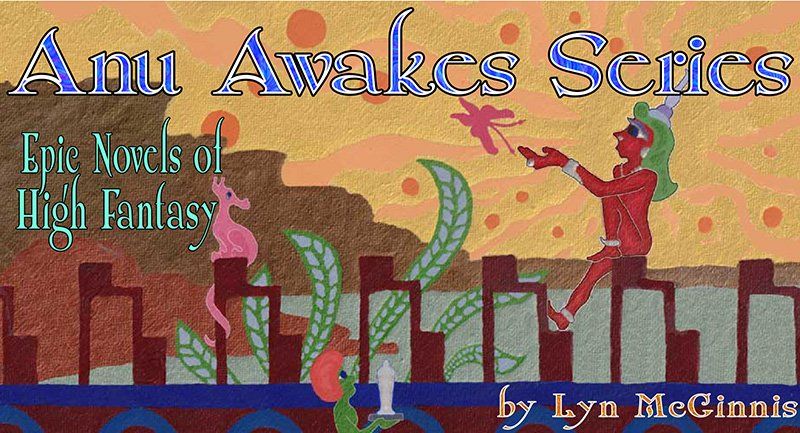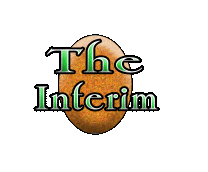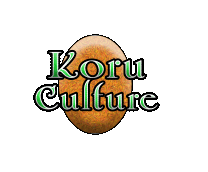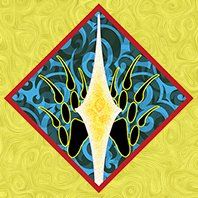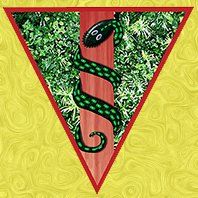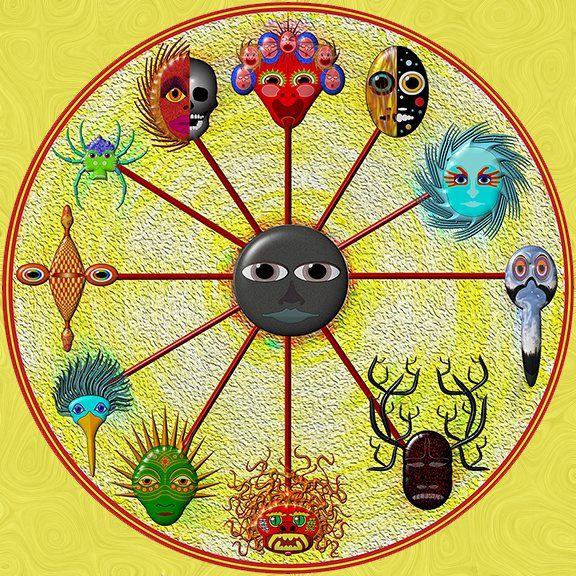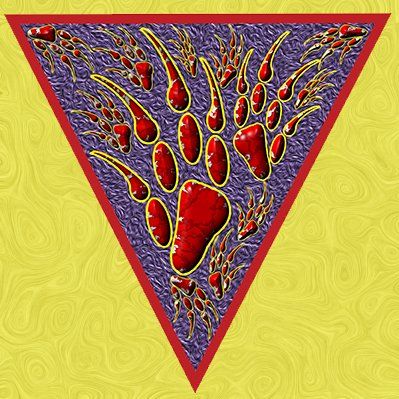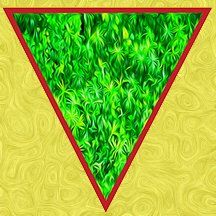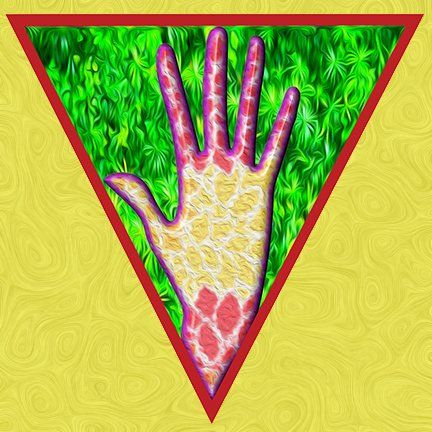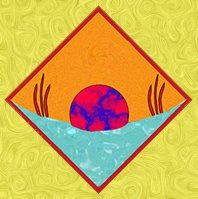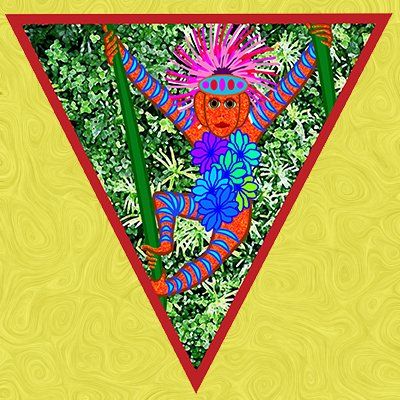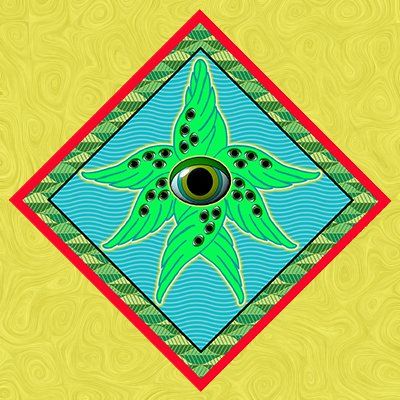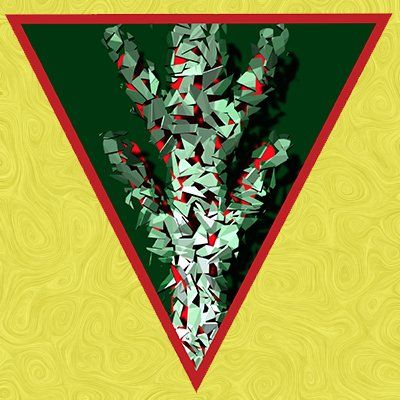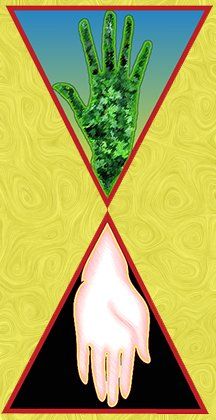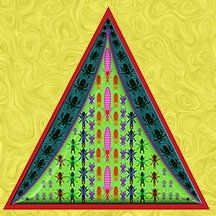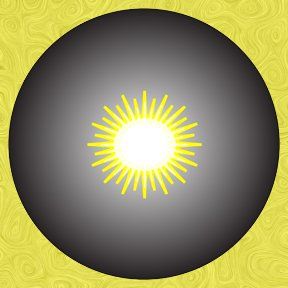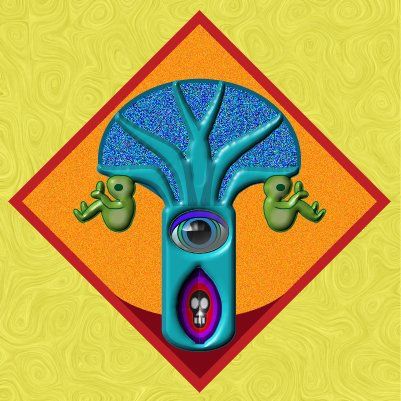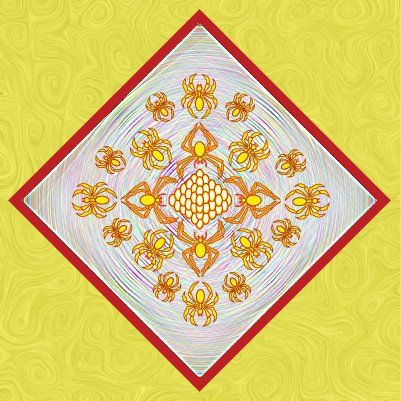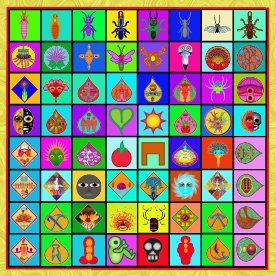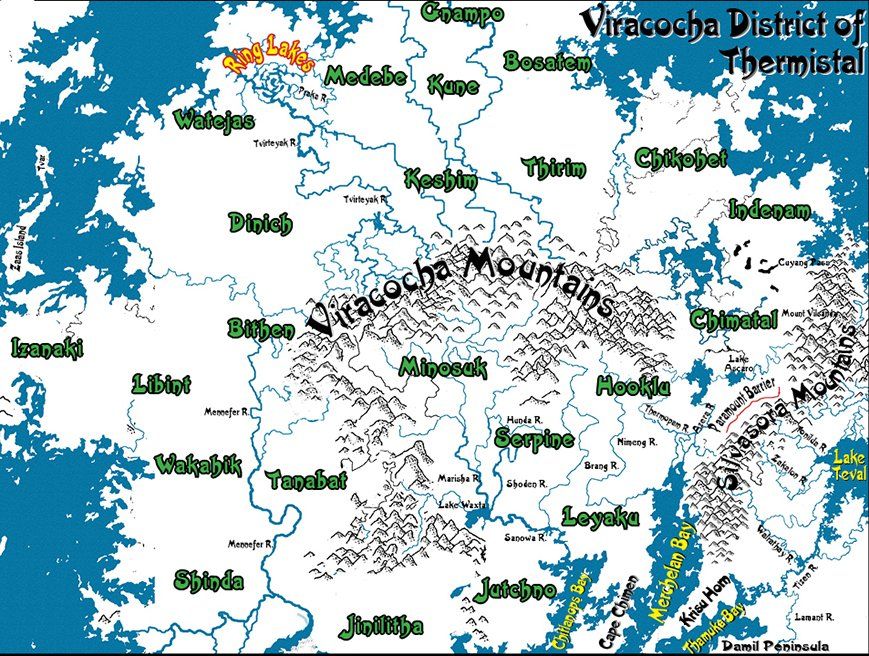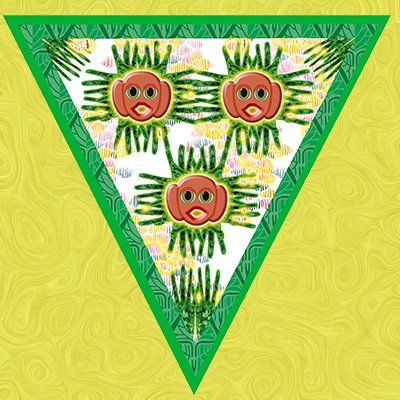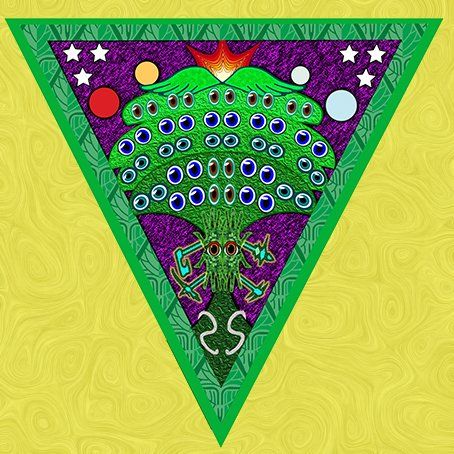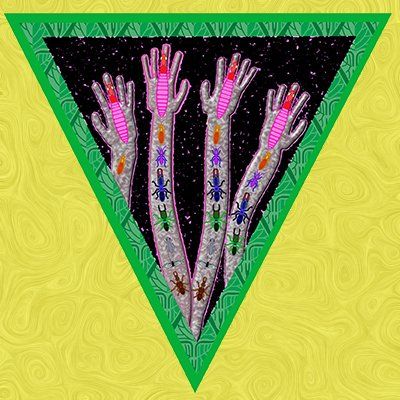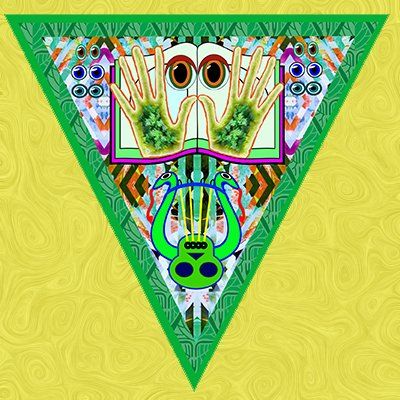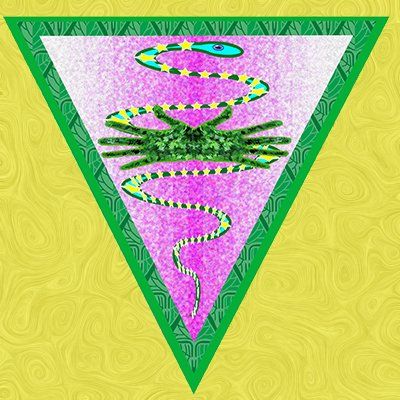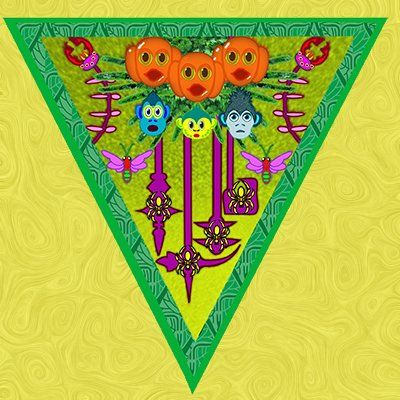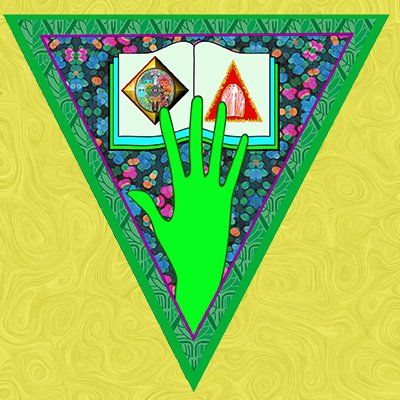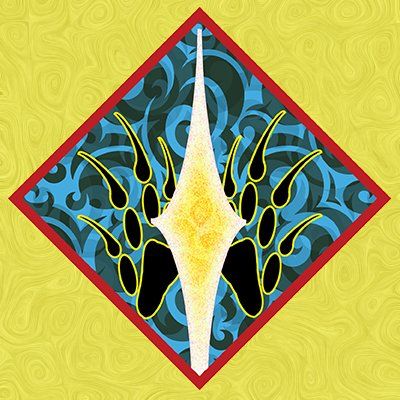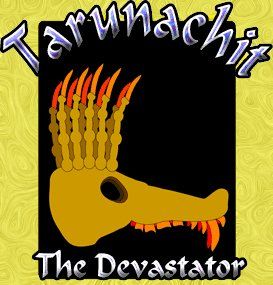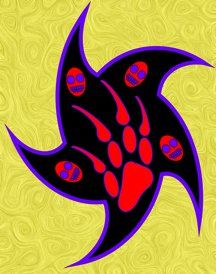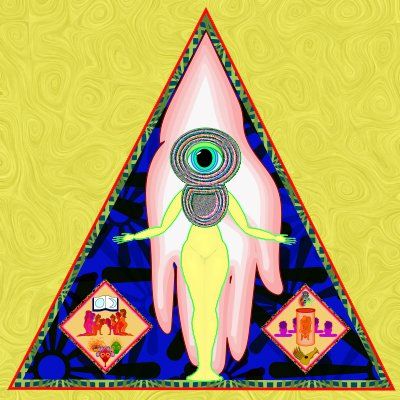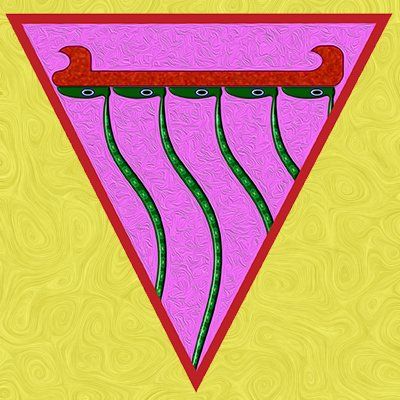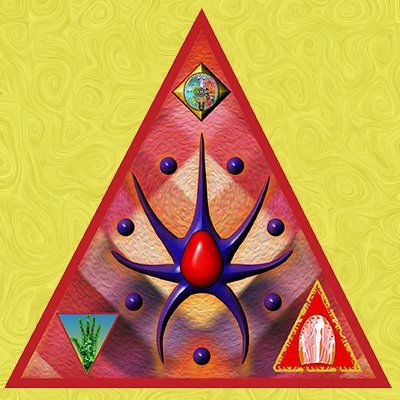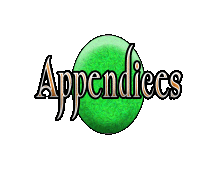
Yakku culture contains several contradictions. At their root is one truth and numerous contending mythologies concerning their origins. It is verified that the last Tolku reached the Viracocha District beyond the Silvasora Mountains after The Killing Swath survived. This was due to the unlikely persistence of a former Tolku Cluster-of-Clusters Nation ministry. Known as the Viracocha District Flora Ministry, it had been charged for over one hundred Aeons with the specialized work of growing and perfecting many new and remarkable flora and fauna. These specimens possessed many unique features within the vast western forests and jungles of Thermistal. They did so by various means, including extensive work within the Tatchlan System throughout the Greater Era of the Primary Epoch. Due to their surviving in sufficient numbers and possessing their specialized knowledge and resources, the refugees continued in a new life high in this intelligently designed canopy.
The many mythologies growing up the subsequent millennia vehemently deny this truth.
Primary Epoch
Suvuka defeat, Tolku exploration of Viracocha District, Tatchlan employed, Invocates and Operants work on the ‘inside'
Secondary Epoch
Mystery of remaining, Onslaught preparations, Refugees arrive, Suvuka Onslaught of new forest nation, Silvasora Mountains, Paramount Barrier, Barrier modified, Viracocha onslaught, Falling into the trap, Trap set again, Pause in assaults, Three armies on three fronts, Changes, Preparations, Three armies defeated, Hungry Rock as weapon, Suvuka response
Yakku
Yakku nation born, New living tools, Cousins and Krall, Yakku's management of Karthala, Cultural divergence, Disturbance Theory, Suvuka move again, Stalemate becomes status-quo, Yakku mysticism, Overview of idea systems, Nu and Sky Fire, Untasha-Kabash, Eight Levels Head Chest, Upper Arms, Upper Hands, Upper Body, Lower Body, Lower Arms, Lower Hands, Hands of Service, Level Traditions, Eleven Winds, Constant movement, Body mysticism, Mahakram Perfection symbol, Bowvow innovation - Wajah, Wajah authority and controversy, Nests and Levels, Crown Rises, Twenty-Three Regional Trees
Yakku meet Koru
Year 178 of The Interim begins Happy Century, Declaration of Regret over Suvuka, Koru colony in Viracocha Mountains, Growing unease, Challenging Legal Code changes, Partial travel bans
Siv-Sa
Triplets abilities, Devotion and ‘thicket foolishness’ Satyrical songs, Anu Tree, Animal Songs, Purity of the Air, Sampling of Siv-Sa chants, Triplets criticize Body Mysticism, Hanging the Dead, Dark Visions, White Worms, White Hand Battle, Triplets death at the Ring Lakes, Triplets death linked to first Koru Majastas, Four Schools, Aizen Coterie, Sif Discipline, Djingal Votary, Miming Academy, Aizen Sagas controversy
Koru Majastas Crisis
Koru Majastas Zudaz I travels to Thermistal, Reaction outside of Bithen, Swaying Wajah cry out, Wajah divisions, Koru Majastas defeats Suvuka, Crisis of confidence, Suvuka retreat to Thermistal, Suvuka weakened, Fifty years later Majastas Zudaz I returns, Surprising Yakku response, Djingal Votary ascendancy, Desire for vengeance against the Suvuka, Aizen Coterie and Miming Academy dilemma, Djingal Votary aided The Tarunachit
Suvuka Extermination
War begins on Lewetar Island, The Tarunachit march east, Suvuka choose final theatre of battle, Djingal Votary provides logistics, Pramath Island, Broken force divided, Two narratives for two audiences, The Remainers, Koru silence
Yelda debate
Three distinct classes of Yelda on Rho-Jashun
Fear wrapped in mystery
Yakku secrets, Hidden Waving Arms, Hungry Rock mastery secret, Water Column event at Ring Lakes, Yakku dilemma, Underlying unease, Second Majastas causes The Rift
Danam Yelda resolution
Suvuka defeated
Master Duamang’s weapon broke the rule of the First Suvuka Onslaught in pre-Tatchlan times. As their numbers dwindled, they were driven from Rho-Jashun, and then, on their native Thermistal, they were pushed eastward across the continent. The victorious forces set up an extended blockade in the east. At the same time, the engineers took advantage of a set of geological features to create the enormous water barrier known as the Vettencore Passage. Once established, the Tolku forces took to the western side of the passage to raise additional walls, effectively sequestering the Suvuka on the easternmost portion of Thermistal. While the intensive maintenance of the Vettencore Passage barrier is well known, this was far from the only Tolku activity on this newly possessed continent.
Once the
Suvuka were contained, the
Tolku undertook an exhaustive survey and mapping programme of the rest of the continent for the victorious
Muraharoma Dynasty of
Statos-Vey. Among many other wonders, the impressive diversity of trees and forest life, unique to Western
Thermistal, were catalogued.
Given the region is surrounded by the westernmost of the continent’s three mountain ranges, it was named after the mighty
Viracocha Mountains. There, it was found that a specific set of conditions proved ideal for dense growth and the proliferation of many distinctive ecological sectors. Within these singular enclaves, dwelt species rare or unknown elsewhere on
Anu. Various specialists were dispatched to begin an intensive study of all aspects of this region. Encyclopedists followed to record and publish extensive works detailing each feature of this flora and fauna, along with all else found throughout what had been a mysterious continent.
Tatchlan employed
Based on ongoing research of subsequent generations and the flowering of the Tolku Cluster-of-Clusters Nation, the western portion of Thermistal organized into twenty-three substantial forested regions. These were known as Estates (these eventually became the Twenty-Three Regional Trees of the Yakku). Within these Estates, the now well-documented cornucopia of Western Thermistal was carefully refined and cultivated. Occupying different latitudes and subject to local environmental conditions, specialized hybrids were fashioned in each estate before being distributed elsewhere.
Invocates and Operants work on the ‘inside'
In a separate initiative, also employing generations of thousands, specialized Invocates and Operants were able to find and identify each particular species within the Living System and thus be able to modify them ‘from the inside.’ Once established, this mighty initiative was combined inside and outside the Resplendent System, and a Generational Plan enacted. As with many other raw forms of life on Anu, directives were issued to begin an ambitious series of Millennial Programmes to polish and enhance this vast population of majestic and powerful beings. They were to imbue them with even more specialized abilities than they already possessed, combining and engendering new ones. The ultimate goal was to make them vital and harmonious parts of the global manifestation of Tatchlan on the Skin of Anu. This Generational Plan continued at varying intensity levels throughout the Primary Epoch. All this became the province of what was known as the Viracocha District Flora Ministry. For reasons imperfectly understood, very little of the Tatchlan improved flora and fauna were affected by The Killing Swath.
Mystery of remaining
The Killing Swath affected all Anu, including the Viracocha District. While a most of those employed by the Viracocha District Flora Ministry met the same fate as all other Tolku of Anu, a small number survived. This tiny remnant managed to gather and reorganize themselves successfully. What they did next laid the foundations for all subsequent Thermistal history and, eventually, the state of Anu for much of the Secondary Epoch. The surviving remnants of all other ministries elsewhere on Anu followed the Tolku Proclamation and initiated what would become the Generational Journeys to the Sanctuaries on Rho-Jashun. Honoured Historians have pondered why the surviving Viracocha District Flora Ministry did little to reach the Sanctuaries, given they had the shortest distance to travel to Rho-Jashun.
Onslaught preparations
Instead of sailing south, most focused on employing their vast knowledge and facility to survive within their now highly specialized Estates. There are tales of emptying their former ground facilities and moving everything up into the forest canopy as part of their preparations. They seemed to have understood that there would be a Second Suvuka Onslaught. Given their modest numbers and intimate knowledge of the topography around the ‘Three Gateways,’ the most likely areas of incursion, they focused primarily on the five Estates just west of the Silvasora Mountains. These are now the Jutchno, Leyaku, Hooklu, Chimatal and Indenam Regional Trees. By Year Nine of The Interim, the year the Raw Suvuka breached the Vettencore Passage, the two Estates most likely to be invaded, Hooklu and Chimatal, were in advanced preparations.
Refugees arrive
As the Viracocha District Flora Ministry fortified these five Estates, the first Tolku refugees from across Thermistal began coming through the Silvasora Mountain ’Gateways,’ primarily the Tonilda, the least arduous crossing, to the critical Estates of Hooklu and Chimatal. They carried with them tales of the coming Suvuka onslaught. The traditional date for this first wave of migration was the Year Eleven of The Interim. The earliest known Yakku traditions unanimously say these refugees found their saviours already high in the trees.
Armed with strange instruments, employing exotic creatures, and managing various animals, plants and hybrids, they swiftly conducted each wave of refugees into the forest canopy. These bedraggled and starving survivors discovered a highly organized arboreal society based on the vast knowledge and expertise of the Viracocha District Flora Ministry at their disposal. With a strict hierarchy and command structure, this decidedly marshal organization mobilized these disparate and exhausted survivors into a well-functioning force. The newcomers were educated intensively on thriving in this new environment and employed various living and fashioned tools to repel the coming enemy. It is estimated that this rescue and preparation process lasted nearly two years before the Suvuka caught up with them. This delay was due to the beasts laying waste to all Tolku monuments as they moved westward across the continent.
Suvuka Onslaught of new forest nation
When the first small waves of Suvuka began arriving on the edge of the Silvasora Mountains in Year Fourteen of The Interim, they surveyed the terrain and found the ‘Three Gateways.’ While small parties attempted to cross the two southern gateways, the Walrathay and Zakalon, most of the hordes focused on the most accessible Tonilda Gateway, the northernmost and closest to the Grand Lake Teval. All three campaigns failed due to their being surprised by death from above. There are passing references to fire being employed along the extremely uneven, narrow, and twisting paths of the Walrathay and Zakalon, but no details remain. Those successfully surviving the Tonilda passage found their actual battlefield - the towering forests. None returned to the swirling herds on the Lake Teval Basin. Subsequent waves in the following years halted before piles of vine-wreathed bones lying in great heaps among the towering trees.
Initially, the Suvuka did not realize where their prey was and fruitlessly moved about in the forest only to be picked off. Once they determined the Tolku were high in the canopy, they began climbing the trees, only to find many traps laid on the trunks to dispatch them shockingly. This often left gruesome trophies covering the trunks for them to ponder. The Suvuka had never encountered these living and fashioned weapons before, and these surprising developments halted their advance.
Even without traps, the trees provided many challenges as some mystified their eyes, blunted their noses and muddled their thoughts. All this caused them to become lost just a short distance into this bizarre new world they encountered before being dispatched. It appeared to observers that the Suvuka rightly saw this strange flora as another work of the Tolku. They began attacking the pungent walls of scrub and dense trees, only to find the forest quite able to defend itself. These first waves ended in defeat and confusion, and the enemy regrouped beyond the borders of the mountains. The Suvuka were monitored as they appeared to undergo ferocious contention as to how to proceed. While the Viracocha District Authority’s defence was unexpected and devastating, this was not the Suvuka’s only problem in Western Thermistal.
Silvasora Mountains
The Mandeca Mountain Range further east is near impossible to cross over but bypassed by going through the Kukernef Desert to the south or the Farkhund Pass to the north at the shores of the Arushoon Sea. The Silvasoras presented their problematic ‘Gateways’ for the Suvuka moving westward. This mountain range bunches between the northern coast and the Tharapura Ocean, where only one tiny opening, known as the Cuyang Pass, exists. The southern spur reached Merchelan Bay, effectively dividing what will become the Viracocha District from the rest of the continent. The Three Gateways present themselves only in the centre, at the sources of the Tonilda, Walrathay and Zakalon Rivers. This meant the vast hordes circling Lake Teval, their most-ancient ceremonial centre, could not continue their westward assault in numbers. It has been speculated their long sequestering behind the Vettencore Passage had eroded many details in their oral lore concerning the landscape of Thermistal. The Silvasora Mountains forced them to move in small groups through these twisting passes. Once through, they faced the strange animate forest filled with Tolku and something even more dangerous.
Paramount Barrier
The Paramount Barrier is one of two distinctive formations on Thermistal on a scale not found elsewhere on Anu. It is a vast and terrible gash in Anu’s Face, travelling erratically nine thousand, five hundred and eighty-seven andas southwest to northeast. It roughly follows the Silvasora Mountain ranges’ western flank at eight to nine hundred andas to the west. This means it occupies the southeastern portion, of which nearly half is in the Hooklu Regional Tree and half is in the Chimatal Regional Tree. The width grows from a handbreadth at the ends to half an anda for most of its length.
As impressive as its range is, its depth is even more profound. Records from the Greater Era of the Primary Epoch show that the Tolku thoroughly explored and mapped its extent. The floor rises and falls, ranging from half an anda to a mighty four andas in depth in many sections.
It is of sufficient depth that Anu’s heat issues notably out of the fissure at its deepest extent. Unique flora and fauna exist within that are found nowhere else on Anu. Over millennia, the Barrier had widened at an immeasurably slow pace. Beyond its extraordinary dimensions, another remarkable feature noted by the ancients was the fact water does not collect and fill this cavity. Most of the rainwater appears swiftly siphoned away by several denizens of this unique setting - what is left drains elsewhere or evaporates on the warm cavern floor. The interior is ever hot and moist. The name ‘Paramount Barrier' was unknown during the Primary Epoch; it came at the start of the Second Suvuka Onslaught. A more extensive laceration is found in Eastern Thermistal forming part of the Vettencore Passage. It joined the Arushoon Sea's southernmost meanderings to create the separation of Eastern Thermistal and thus contain the Raw Suvuka after the first Onslaught.
One more formation is found on Anu, known as the Bulbogal Trench. It is located in southern Rho-Jashun. This trench formed a portion of what was known as the Impenetrable Barrier Region just north of the wall of the southern Mulungu Mountains during the Lesser Era of the Primary Epoch. This was the first recorded instance of the Suvuka being tricked into unwittingly stampeding into this cavity. They were destroyed in great numbers there during their First Onslaught. The emerging Viracocha Authority was known to have records of this event and repeated those preparations to fool these herds into running to their ruin.
Venerable Scholars and
Honoured Historians have speculated on how the Suvuka, who ruled Thermistal for uncounted millennia during The Lesser Era, appeared ignorant of this prominent feature. Most conclude there were likely their versions of oral traditions, but with their long sequestering in eastern Thermistal, this lore was forgotten.
This emblem depicts the modified version of the Paramount Barrier (see below) seen from the side. The proportions of the drop between the western and easter lips are exaggerated. The vapour is meant to depict the familiar sight of steam rising through the gap, especially early in the morning, and the stench of the dead Suvuka at the bottom.
Barrier modified
What in The Interim became the Viracocha Authority appears to have had some knowledge of the Tolku Proclamation at the end of the Primary Epoch. Thus, they realized a Second Suvuka Onslaught was at hand. The Authority made this natural feature a key component of their defensive strategy. One portion of their plan involved the excavation of sections of the western lip of the barrier so it was lower than the eastern side. This reduced the visibility of the gap, especially if those approaching did so at high speed. After crossing the torturous passes of the central Silvasora Mountain range, a few locations were deemed most likely for the Suvuka hordes to form their killing swarms.
Another aspect of this plan was the mass planting of Tamaroth Trees. These are quick-growing and relatively short-lived trees, reaching maturity in less than ten years and seldom living more than forty. Their Primary Epoch predecessors had perfected growing trees of specific girth and widths of their characteristic trunk stripes for various uses unrelated to their current threat. They also fashioned an odd attendant for these mesmerizing forests known as the Gidalist, which would become a vital servant to the Yakku in subsequent history. The quickly gathering survivors of the Viracocha Authority planted thicker trunks with wider stripes on the western slopes within the first five years of The Killing Swath.
Over the following decade, they planted thinner trees on the eastern slopes with smaller streaks. The result was an optical illusion for the stampeding Suvuka. Ahead would appear to be a continuous forest of already confusing stripped trees of similar size and age when a yawning gap lay hidden between them.
Viracocha onslaught
Once the Suvuka discovered this Tolku stronghold, they continued their assaults despite heavy losses. The Tolku were by no means safe in their canopy. By sheer brute strength, the Suvuka won some success in bringing down some or successfully climbing up to kill others. The Tolku developed the severe practice of saving their dead, by whatever cause and using them as bait and lures. While the trees, the powers and knowledge of the Viracocha Authority ensured the survival of most, many suffered terribly during this time. Gradually, the Suvuka appeared to carve out avenues successfully by physically tearing down entire stands of trees with overwhelming force. The Viracocha Authority continued to mount a defence while quietly preparing the trap that was the Paramount Barrier eighty andas further inland. They began surreptitiously downing some trees at certain junctures long before the Suvuka arrived to encourage them to continue in one direction and discourage them from others. The Suvuka developed a pattern of staging a series of assaults at certain times of the year, followed by periods of their returning to the Lake Teval Basin, where innumerable herds continued to dwell. Scouts reported several times a year they mounted a massive Ceremonial Run around the shores of what would come to be known as The Grand Lake before commencing another campaign. It is recorded the tumultuous clamour of these massive assemblies could be heard deep within the Silvasora Mountains to the west.
Falling into the trap
After twenty years of these sporadic actions, by Year 34 of The Interim, the Suvuka were finally drawn into the trap. The land appeared to open up sufficiently for them to build a mass to travel together. Large numbers threaded their way through the Tonilda Gateway and continued through their carved-out passageways with little resistance from those above. They gathered in the cleared area, determined to smash through more territory, carve up, and bring down the forest. Tremendous care was taken to groom the region to bolster the deception. Tamaroth Trees, long an irritant to them, did their part to create the illusion of the way being open ahead. It is said a group of several thousand performed one of their marshal dances before they began, ensuring all those taking part were together at the beginning.
On the other side of the Barrier, the Viracocha Authority had thousands stationed who now blew various horns meant to simulate and amplify the sounds of Tolku screaming and crying. They had to use horns to amplify their voices, which would otherwise have alerted the Suvuka to them being further away than they thought. At this sound, the Suvuka bellowed and began their run towards the noise. The illusion was maintained until the last paw left the ground, only to find nothing underneath their next step. As each group flailed and fell headlong down into a vast depth, swallowing their cries, those behind continued unaware until they, too, were surprised to be following those before them. The Tolku, on the other side, now switched to a different set of horns, crafted to sound like the Suvuka’s enraged roaring. This helped to mask the few cries escaping from those already falling while enflaming those behind, eager to reach what they thought was a battle.
The spectacle was described as a thunderous waterfall composed of thousands of bodies flowing in pulses into the barrier. A rushing sound followed this as they twisted and turned while sailing downwards. When the last few reached the edge and were not knocked over by those behind them, archers rained arrows on them to ensure none escaped. A few Suvuka managed to stop their fall by digging their prodigious claws into the walls of the Barrier. As soon as they had climbed up to be in range, they were shot down.
Trap set again
Once it was determined every single Suvuka was dead, the Authority returned to the area via bridges set across the Barrier. They removed all vestiges of the large company that had just gathered there. They washed the ground, cleared debris, and brought in Tamaroth saplings and young trees to replace those smashed and broken swiftly. They employed a specialized agent to remove all traces of their and the Suvuka’s scent from the scene. Within one day, they had removed all evidence of the Suvuka army having been there. This included some thousand loose talons littering the ground near the Barrier’s edge, which they claimed as trophies. They then moved back along the track, sterilizing all indicators of the Suvuka’s passage.
Watches were set high in the canopy far ahead of their progress to ensure warning if a second wave of Suvuka began. None came, and the entire operation of removal of all evidence of their passage was completed. These included such elaborate measures as ‘combing’ the tree trunks to remove tufts of Suvuka fur adhering to them. There are records of a timely storm washing the region after these operations, further obscuring all evidence of events. Observers within the Silvasora Mountains watched for any warning activity of the vast hordes out on the Lake Teval Basin but saw none. After a two-week, another large company moved towards the mountain passes. With the alert, the entire process repeated. It is claimed that this time, nearly ten thousand Suvuka followed the same course and met the same end. With none returning, those Suvuka surrounding Lake Teval had no way of knowing what happened. Yet, there appeared to be a change, and no further incursions occurred for a time. Whatever most-ancient songs the Suvuka preserved during their captivity did not consider that the Barrier was widening to such a deadly extent and depth in their absence.
Pause in assaults
While not knowing what happened, the Suvuka appear to have realized their two large companies had ended badly. Given that the prevailing winds were out of the West, despite the great distance, they may have caught something of the aroma of death issuing out of the Paramount Barrier, which records report was prodigious. Their movements near the mountains had now changed. They withdrew from the grasslands between the Tonilda and Zakalon Rivers. The vast Ceremonial Runs continued several times a year, but no aggressive forays followed.
Three armies on three fronts
In the Year 44 of The Interim, a herd numbering nearly ten thousand was seen heading South. They moved like a dark shadow across the land, fording the Walrathay River and continuing down the last of the southern foothills of the Silvasoras onto the Krisu Horn. They pressed further south until the Merchelan Bay narrowed and swam across to Cape Chimen. Once all were ashore, they staged one of their massive ceremonial displays before heading north into what had been the Leyaku Estate. From this direction, the Paramount Barrier was no defence. At the same time, another group of similar size began moving north. They passed out of the northern extent of the Lake Teval Basin, forming a long line to thread their way through the tight passes of the Northern Silvasoras. They finally came out in the Neathom River Valley. It was clear they were making for the Cuyang Pass and Indenam Estate. Finally, the third force of equal size began to move directly for the Tonilda Gateway. These approaches were staggered, with the Southern army starting first, then the Northern force and finally, the Eastern force. It appeared they planned on converging together on the far side of the mountains in a concussive action.
Changes
Unbeknownst to the converging armies of Suvuka, their quarry had changed. Notwithstanding many hardships, the population of the Viracocha District had doubled since the first Suvuka incursion. In the Year 44 of The Interim, population was about to double again. The four former Viracocha Flora Ministry Estates of Leyaku, Hooklu, Chimatal, and Indenam now teemed with a young and vital population, and early work was underway to colonize the old Estates of Jutchno, Serpine, and Chikohet.
There was an even more startling development. As with the inhabitants of the Sanctuaries on Rho-Jashun, their bodies had begun to change. The children of the survivors now assumed leadership roles within the Viracocha Authority. During their childhoods in the trees, their young bodies had displayed surprising changes in proportion and other attributes. Like those becoming Koru on Rho-Jashun, the next generation was already showing signs of becoming Yakku.
Their torsos lengthened, their limbs extended, and the digits on their hands, particularly their feet. In time, they would refer to their legs as ‘lower arms.’ All of this meant they moved with increasing agility through the canopy while having less and less to do with the forest floor. An increased strength matched their notable change in proportions and size. The third and fourth generations, now born in the canopy, displayed early signs they were continuing to change and would surpass their parents’ abilities. While appreciating this shocking transformation was likely an end product of the effects of The Killing Swath, it was welcomed as they moved from their former world into a new life. With this came growing confidence in their knowledge and ability to meet this threat.
Preparations
Long before the signs of a new attack, the Viracocha Authority had planned for this eventuality. From the day of the second Suvuka ending at the Paramount Barrier, the first generation looked to the likelihood the Suvuka would change their approach and tactics. It was inevitable they would attempt to reach them another way. The only two likely courses for them were coming up from Cape Chimen and down from the Cuyang Pass. What was not foreseen was a third force would still enter the Tonilda Gateway, making clear that the Suvuka had no notion of what happened to the previous invaders. The second and third generations were armed with the experience and knowledge of their recent and ancient ancestors of the Viracocha District. They marshalled all their resources to surprise their invaders coming north and south. At the same time, they maintained the strategy to channel the central force to the same fate as the previous two Suvuka hordes at the Paramount Barrier. There are records of specific flora being employed to help mask the faint residual stench of the tens of thousands of pulverized bodies deep within the Barrier. Still, commentators noted that the Suvuka’s frenzy overcame any hesitancy caused by this residual olfactory warning.
Three armies defeated
Long tales, and many songs exist, extolling the following year's events. Suffice it to say the three Suvuka armies each suffered terrible defeats in their attempted invasions. A new creature directly met the southern Suvuka force, similar but far more substantial and robust than the original Tolku. They deployed a dizzying array of weapons, including projectile poisons and invisible traps falling from above and appearing suddenly out of the ground. The old challenges of strange trees with unforeseen abilities still proved lethal. They also met these new Tolku in direct combat. Two Yakku, armed with various terrible devices, worked together to bring down a single still far more massive and powerful Suvuka. They did so while remaining in the lower branches of large trees, often hanging upside down by their knees. The northern force also encountered mighty projectile weapons, deploying specialized trees and other life forms that could fling a killing array of living missiles from great distances.
They also met these unexpected warriors in their killing pairs showing none of the fear of the earlier generations of Tolku. They wielded terrible slicing and piecing weapons filled with toxic venom, which not only dispatched their prey but swiftly reduced the carcass to a smouldering heap. The central army suffered the ignominy of falling into the same trap of the previous two campaigns. The three forces never came close to joining, and great pains were made to ensure none of them survived. As a final act of defiance, they collected thousands of severed heads. Using catapults, they rained them on the herds out on the Lake Teval Basin. Their range was so far and powerful that many were killed or maimed. Those that missed pockmarked the ground.
Hungry Rock as weapon
Later generations of Koru and Yelda were amazed to learn that Hungry Rock became one of Yakku’s secret implements. Displaying their unique genius, the Yakku had found a way to employ these non-living entities in ways unimagined by either their contemporaries or the ancient Tolku. By novel craft, they could collect and carry small portions of this ‘Gentle Consumers’ surface rind over great distances to spray them in close quarters directly on the Suvuka. They could also extract intact sections, transport them elsewhere, and pour them into new formations. Some new pools became smaller versions of the trap at the Paramount Barrier. This shocking ability was not revealed until the concluding millenniums of the Secondary Epoch.
Suvuka response
The population of Suvuka, having reproduced even more proficiently than the emerging Yakku, was vast beyond count out on the Lake Teval Basin. Yet, this catastrophic defeat forced their intense ardour for destruction to cool. For twenty years, they made no move to leave the basin. In Year 69 of The Interim, a relatively small group numbering two thousand began to move south slowly. Of themselves, they were not an invasion force. However, they were still followed closely by those now naming themselves Yakku (see below). These Suvuka initially followed the same route as the southern army. Yet, instead of turning north after swimming to Cape Chimen, they crossed it, swam Chitlanops Bay, and stayed on the south coast.
This was the only group that moved out of the Lake Teval Basin north or south. Despite their modest size, the Yakku continued to follow their movements. The Suvuka followed the coast except where it went inland. Then, they would swim across the bays, inlets, cross islands, and peninsulas, always heading south and west. They moved leisurely, with no running and no ceremonial displays. They would interrupt their seemingly aimless voyage with intermittent periods of extended rest, foraging and leisure before calmly starting again. The Yakku made no secret of their surveillance, but the Suvuka appeared to ignore them and continued their slow progress. In Year 71 of The Interim, they reached the southwestern tip of Thermistal in what had been Shinda Estate in the delta of the Mennefer River. They settled there and only moved beyond hunting forays around the delta, where they also proved proficient fishers. After five years, they displayed no signs of moving. Elders died, and many new pups were born, and they continued to dwell by the mild surf of the Panchala Sea.
Yakku nation born
While forces continued monitoring both this small group and the main body of herds east of the Silvasora Mountains, the Yakku fully came into being. With each generation, their physical transformation continued. Along with elongated bodies, they developed new abilities to slip in and out of their joints and arrange themselves in unlikely postures. Later, when walking became difficult, they acquired the ability to travel at speed over open ground. They did so by performing extraordinary flipping and cartwheeling to the amazement of both Koru and Yelda.
Their skin developed into a tough hide to withstand constant exposure. They gradually took on the ability to change hue at will based on the expansion and contraction of a wild variety of spots of different tones now covering their hides. They even cultivated the ability to school these patterns to match their surroundings, including the stripes of their Tamaroth Trees.
Their faces changed as well. Gradually, their noses grew smaller and their ears far larger. Eventually, these would form significant flaps on either side of their head. These notable ears become potent tools to read many sounds at great distances. Their movements also become readable signs of their emotional states. Other changes included a modified voice that could easily mimic a wide variety of the unique flora of their regions. They used these abilities to make extended songs that would travel many andas in the desired direction. They took their natural ability to whistle and fashioned an impressive proficiency to project a sophisticated vocabulary of sounds covering entire regions. All this led to these ancient Flora Ministry Estates ringing with a constant backdrop of local and longer-distant communications each day. They also developed what can best be described as two vocalizations that could be a prelude to assertive or aggressive action. One was a deep buzzing call and the other an intensive clicking, both of which could be thrown to appear to come from several directions. At the same time, they gradually fashioned a new set of languages for face-to-face communication that could be characterized as near whispering. Accustomed to this range of speech, they would describe the Yelda's louder and more resounding voice, particularly the Koru's, as being made by ‘Droners.’
New living tools
The Yakku built upon the generational research and species modifications of the now ancient Tolku ’s Viracocha District Flora Ministry. The total of this ministry’s vast accumulation of knowledge and specialized tools became the shared legacy of the Yakku. Following the established protocols, they continued cultivating and modifying their living patrimony. The one missing aspect was little to no activity within the Living System complimenting their surface work. There was a profound cause for this lack of inner movement. One example of this was harnessing the native Sivist of the forests to refashion the Waving Arms highways of the Primary Epoch to connect all the former estates. This would be a long-term venture not fully realized until the withdrawal of the Suvuka.
Cousins and Krall
It is impossible to overstate the importance of the Yakku’s perfection of the relationship between themselves and the arboreal Cousins, the Asaku, Mayku and Tecku. These tiny creatures became completely bonded and, over time, profoundly altered into steadfast companions and servants of the Yakku. They came to understand and respond to complex voice commands and other signals and fulfilled many vital roles in day-to-day life. They became so integral to the Yakku life that they were given legal designation within the Yakku Collective.
To a lesser extent, the Yakku also employed the ground-dwelling Patzku into their society and trained them in part to join their other Cousins and the Yakku in at least the lower levels of the trees. The Yakku embraced these branches of the Cousin family with three exceptions. They avoided all use of the Varku and larger Tamku and Toboku. The Tamku and Toboku were too large to be used in the canopy. They did assist these giants in finding refuge high in the Silvasora Mountains, where the Suvuka were less likely to hunt them, but beyond this, they had little to do with them.
The more significant issue was with the Varku, who were seen as powerful agents for Tatchlan. It was well known that the Varku was significantly modified, both by the most-ancient Tatchlan Masters and the Tolku Majastas throughout the Greater Era of the Primary Epoch. There was a fear that their ability to communicate and command the other branches of the Cousin family could subvert their small Cousin population.
While all Cousins held the Varku in high esteem, the large Tamku and giant Toboku appeared primarily subservient to them. This was another reason they were not included in the new Yakku arboreal society. Still, it is likely very early in Yakku history; all Varku were hunted down and destroyed throughout the Yakku Viracocha Collective. There is no definitive documentation to support this theory.
Similar suspicions surrounded the extensive flocks of Krall. Despite being more common near fresh and salt water, they often circled far over their heads deep within the Yakku Collective. The Yakku knew of the significant alterations done to them by the Tolku Majastas during the Primary Epoch. They were said to act as ‘Eye Windows’ for the Tolku to view distant events. Still, the Yakku realized they could not significantly reduce their numbers and shut them out of their animal relations. A tradition of derision of these birds is associated with filth and thievery. Their introduction into any drama or song signals trouble ahead as the bird became a traditional sign of ill-omen. One of Asaku's ongoing tasks is alerting any populated portions of the canopy to their presence. Eventually, there were even religious myths of their being in league with the ‘While Worms,’ the Koru. Surprisingly, despite all this lore, the Siv-Sa triplets never mentioned them in their songs. It is extraordinary to appreciate all these beliefs and actions, given the Yakku’s reverence for most other avian beings.
Yakku's management of Karthala
The Karthala is an underground species that goes through an elaborate cycle that, at its culmination, can tremendously impact a Yakku nest. They are best known for hollowing out elder trees and then vacating the carcass just before it falls apart, hence their ‘exploding tree’ symbol. The original Viracocha District Flora Ministry of the Tolku began work on managing the fifteen- to twenty-year cycle of the Karthala.
They determined to minimize the harm the colony could do to mature forest stands. It appears substantial progress was made within the Living System of Tatchlan to modify their impulses and channel their drives in ways that allow for their management. The Yakku of the Secondary Epoch inherited this lore. They used it to monitor the colony’s life cycle and direct them during their final migration to areas where they wished stands of trees cleared. This is not a perfect process, and there are times when the Karthala are destroyed when their nest is established where it is not wanted.
Cultural divergence
With these noticeable physical and cultural changes came more subtle and profound changes. It is fair to say this population no longer thought as their Tolku ancestors had. Even immediately after Tolku ancestors had. Even immediately after The Killing Swath, this process had already started. There are a few surviving accounts of those who stayed for a time before choosing to journey south and board the last ships to reach Rho-Jashun.
Along with tales of genius and heroism, they also reported a shift in perception and attitude amongst what, at that time, were still Tolku. One theme heard at this time was a turning away from the fallen Cluster-of-Clusters Nation due to the persistent declaration that the last Majastas brought about The Killing Swath deliberately. The emerging Koru of Rho-Jashun came to acknowledge this, but unlike the Yakku, they understood what brought it about. Due to the eventual Koru discovery of the Final Tolku Proclamation, the ‘Killing Swath’ was renamed, at least in academic settings, the ‘Rectification.’ These events are presented in the second novel of this series, Amarel Mountain. The accompanying narrative of this being done out of necessity to save Tatchlan was rejected in Thermistal as an ‘abhorrent doctrine.’ This was seen as the cause of the otherwise mysterious decision to not follow the Proclamation and sail to Rho-Jashun after The Killing Swath.
Later generations saw the emergence of a large body of what came to be known as ‘Swath Tales.’ Despite the name, few mention the actual catastrophic event. Most are romances of the heroic exploits of survivors. Much of this oral tradition was beautiful. Yet, a condemnation of the Primary Epoch and the Cluster-of-Clusters Nation of the Tolku underlay many of these tales. This would eventually be profoundly intensified when the Yakku finally met the Koru (see below).
Disturbance Theory
Many Venerable Scholars, Honoured Historians, and Esteemed Librarians have pondered the mystery of the pre-Yakku shift away from Tatchlan and its impact on the development of later Yakku culture. There is only sparse evidence from the incomplete historical record. Some specialist Koru Invocates and Operants have seen something within the Yakku district of the Living System of Tatchlan. It suggests a fracture lies at its core; something brought about immediately after The Killing Swath. There is something historically known as the ‘Moment of Disturbance.’ This refers to a general dislocation and disorientation, keenly felt by certain Deep Sensitives and subtly affecting the entire population between the death of one Majastas and the rising of the next.
This is a rare occurrence and many Majastas rise and fall without any marked incidence of this phenomenon. There is evidence within the Living System of a profound Moment of Disturbance visiting significant members, or even one single member, of the Tolku Viracocha District Flora Ministry immediately after The Killing Swath. In this instance, no new Tolku Majastas filled the void; it is speculated these Sensitives were damaged by this moment, and their subsequent perceptions twisted as a result. The Swath harmed all the survivors. They were thus more vulnerable to being swayed by those in authority. How this could turn most arriving survivors away from the Beneficent Tatchlan System is unknown. Despite little historical confirmation, there is sufficient evidence for those able to locate it within Tatchlan for this theory to maintain itself.
Suvuka move again
For eleven years, the wandering Suvuka remained in the Mennefer River delta region of Shinda Estate in southwestern Thermistal. In Year 82 of The Interim, they slowly began to move north, continuing to follow the coast. They now numbered four thousand. Still, the Yakku population had doubled several times since the initial clash between them and the Suvuka. The Yakku were swiftly populating all Twenty-Three of the Estates to be found in the Viracocha District. As such, this small group represented no threat to the Yakku beyond those in their immediate area. Surveillance was now taken up by these Estates, who followed them closely as long as they remained in their territory.
As they moved, they often stopped to stare out to sea. No significance was given to this observation at the time. It took three more years for them to traverse Wakahik, Libint and finally Izanaki Estates. Suddenly, they departed from their regime and swam offshore to Zaas Island off the northern coast of the Izanaki Region. This is a large island of over one thousand andas from south to north, the largest off of western Thermistal. It was believed initially the Suvuka had done so by mistake, considering the island was part of the continent. Still, they continued north on the island, and the Yakku lost sight of them for the first time.
Eventually, the Yakku, with some difficulty, left the trees and made their way to Zaas. They found clear signs of the Suvuka and followed it to the other end, where they swam to the islands’ tiny companion, Tvar Island. Eventually, a well-armed Yakku company travelled to Tvar. They found no trace of the Suvuka beyond a single Wum shell washed ashore with a series of unmistakable Suvuka talon punctures in its shell. Then they realized their hubris in thinking the Suvuka of dull intelligence. It now appeared they planned to cross the Panchala Sea all along. Their small numbers and slow progress lulled the Yakku into not seeing their more significant purpose. By their inaction, they had allowed the Suvuka to cross again to Rho-Jashun and Statos-Vey.
Stalemate becomes status quo
The remaining Suvuka of Thermistal settled into their possession of the central and eastern portions of the continent. They were undoubtedly content in the hope their mission to re-enter Rho-Jashun had succeeded. The Suvuka would occasionally test the Three Gateways into the Silvasora Mountains. They now met an ever-vigilant response from a far more formidable adversary than they had known throughout the Primary Epoch. The Yakku came to possess all of Western Thermistal, which they named Viracocha, and to grow a new identity and culture there.
Yakku mysticism
With their ancestors turning away from the Tolku Legacy so avidly embraced by the Koru of Rho-Jashun, the Yakku gradually fell into mysticism. Given their apparent rejection of the Living System, it was necessary to collectively construct a new narrative to believe in to fuel their co-operation throughout their burgeoning population. This happened in small degrees over generations. Those few who witnessed the last age of the Viracocha District Flora Ministry before escaping to the Sanctuaries spoke of a highly rational and organized group, albeit with some unorthodox notions about the Primary Epoch. When the Koru met the Yakku in Year 178 of The Interim, the ruling elites continued in this tradition. Still, the general public had become entangled in a veil of superstition and xenophobia. This tendency grew exponentially once the existence of the Koru and their fundamental differences to the Yakku became widely known.
Overview of idea systems
Traditions grew of trees being treated as wakened beings and assigning the same body parts to them. The root was the ‘lower hands and arms,’ the trunk was the torso, and the bows were the arms. Perhaps it is not surprising that, in contrast to their Tolku ancestors and Koru kin, they viewed what was above Anu as of higher value than below. It is said their former identity and history ‘fell to the ground.’ A new culture grew around a life they now loved dearly. Central to this life were trees, where they cultivated an increasingly elegant existence. Given their arboreal life, it is no surprise they became a society based on ascending degrees, each higher one being of more value than the one below. It is to be noted that all these concepts were far more common in the backwoods than in the urban centres of the Regional Trees.
Nu and Sky Fire
Being oriented towards the sky, the Yakku came to see Nu as paramount. Even so, given the harm he could do, they did not ascribe much in the way of virtue to him. Unlike the most-ancient Chelyakans, they did not believe Nu was alive but a non-living ball of flame. As such, Nu was vital to all life but was also untrustworthy and remote. The Yakku viewed fire as Nu coming to Anu, via ‘bridges’ (lightning) during storms. The traditional Yakku accorded fire from storms profound respect. Still, naturally, they also feared it, given the damage it could do. They developed elaborate protocols to harvest fire from storms while fighting and destroying this Sky Fire if they could not contain it. The Yakku distinguished between this Sky Fire and Dirt Fire. The former came via its bridge down from Nu, and the other was out of Anu. Fire emerging from the ground in any form was deemed vile. It was never harvested for cooking or any other use; it was extinguished with curses. Given the previous sophistication of the Viracocha District Flora Ministry, such backwardness and credulity was a lamentable degeneration of the earlier civilization.
One manifestation of this development was a growing mysticism in the more remote portions of what came to be called the ‘backforest.’ This took many forms but tended toward seeing the trees as possessing consciousness and the Yakku being formed of the same substance. While there were oral traditions, nothing was written down. The one permanent record of these beliefs would be called ‘Backwoods Art.’ Below are three examples.
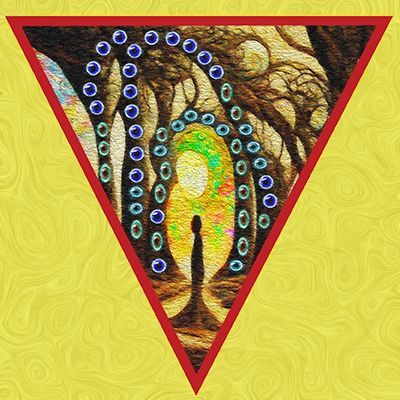
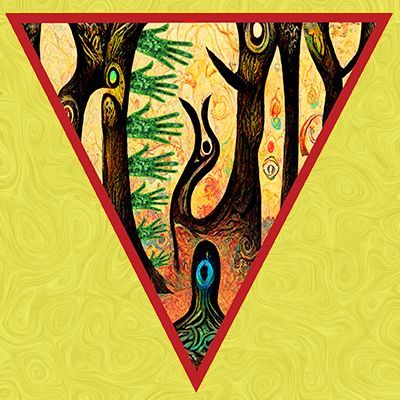
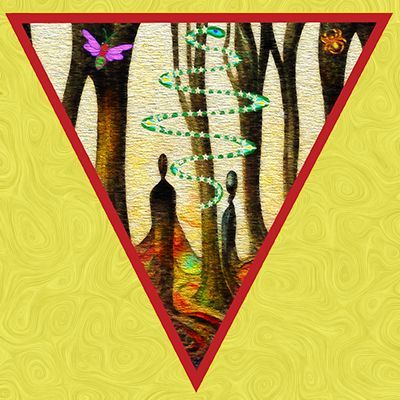
Untasha-Kabash
The Yakku had many names for Nu, but none was more remarkable than one stretching back to remote antiquity: Untasha-Kabash. This is from the most-ancient Tolku religion known as Menem. When the Koru first encountered the Yakku, they were utterly amazed at their use of this title. The fact that the Yakku had access to such texts and concepts from such remote antiquity was a marvel. It must be said the name is apt. Untasha-Kabash was known as ‘the supreme peak of perfection,’ shining in the primordial darkness. In these early times, she embodied a remote and pristine silence. Untasha-Kabash was male among the Yakku but retained all the deities' primordial qualities. Despite the Yakku’s disposition to turn away from the Living System, there is little evidence of their awareness of the Menem religion, the enemy of the first Tatchlan Masters. One of the lesser-known Yakku Sagas appeared to have had the most-ancient Yeoyupan epic as a source. Still, no living Yakku seemed to know the original tale when asked by the Koru.
Yakku Eight Levels
In this Interim Koru Emblem, the levels are displayed in linked pairs forming four sets of interlocking spirals. There is archival evidence that the Yakku Movals formally approved this design, and for a time, it was presented through many of the Regional Trees. After the Rift, only a few continued to show them. Following the rise of the second Koru Majastas, a general prohibition was enacted against any display of this Koru version of what was considered a fundamentally Yakku social institution.
Head (Eighth)
This is the level of all governance and administration within each Regional Tree, along with relations with neighbouring trees and the entire Yakku Collective. The Crown Rises, the highest outcroppings at this level, also serves as the Foremost and Secondary Moval’s residences, their representatives, and all attending offices and departments associated with them. This level also serves as the residence for leadership and administration of the seven lower-level institutions. It also has treasuries, theatres, museums, and other highly specialized educational and cultural venues. The emblem for this level shows a Foremost Moval with their Bowvow Headdress of office, and the symbols for several ministries, known as ‘Hands.’
Chest (Seventh)
This level is devoted to healing. This region includes all medical facilities, medicinal agencies' production, and the associated growing, fashioning and educational institutions.
Upper Arms (Sixth)
This level is essentially the modern version of the most-ancient Viracocha District Flora Ministry. In close association with the Upper Hands level, this is the seat of all management of living resources of the Yakku Collective and the ongoing research and application towards the perfection of these breathing assets of Yakku life. The Upper Arms contains the second and usually most significant percentage of the general population. The design for this level is composed of the well-known leaves of the Mernet Tree, and the three classes of Cousins employed throughout the Regional Tree structure.
Upper Hands (Fifth)
A broad spectrum of sciences, crafts and arts are practiced at this level. As with the Upper Hands of any Yakku, this level sees most of the industry of the Yakku collective. This is also the level for all institutions associated with these professions and avocations. The representation of this level shows three sets of Yakku Hands outspread with an emblem for the Gandahatapan, the aerial insect society, also named the ‘Perfection of the Air.’ This image is present because it symbolizes a unified social industry.
Upper Body (Fourth)
This is the level of maintenance and protection. Those servicing the arboreal society's infrastructure and maintaining vigilance for the security of the Yakku Collective, are stationed here. Their work takes them through all other levels. The Upper Body is the first level, where a sizeable portion of the general population resides. The Upper Body is shown as an arrangement of forestry tools and a halbert designed and used during the Suvuka wars.
Lower Body (Third)
This is the level of pure or acclimatized Yakku young and is traditionally the location of secondary cultural, academic and physical education. Among other things, the Lower Body Level is the place of preparation for the Agility Trials of youth. It is also traditionally the level for adults who must reside here due to temporary sickness or injury. The emblem for the Lower Body is the Mahakram insect society. This image is also a most-ancient reference to the ‘Wise Spider Glyph,’ associated with accumulation and learning.
Lower Arms (Second)
This level is for young Yakku and Yakku Yelda. Those Yelda coming to live with the Yakku for training in canopy life and their attendants also dwell here. Here are elementary and primary educational facilities and specialized stations for those suffering from various challenges precluding them from living at higher levels. The Lower Arms is pictured as a newborn, or pre-newborn, infant.
Lower Hands (First)
The dirt is a place of honour only for the dead. They are buried at prominent tree roots or fed to Bowvow. Their recognition comes from being integrated into the entire tree, thus becoming the home of future generations. Those charged with planting the dead were given high esteem. They may labour at the First Level; they are accorded dwellings in the Seventh. Only disgraced or banished Yakku permanently dwell at the Lower Hands level. Yakku Yelda also comes here briefly to maintain various specialized ground-dwelling resources. The symbol for the Lower Hand is a black skull.
This term is used for the branches of government and administration found within each of the Twenty-Three Regional Trees. These four are shown in the eight levels emblem above. From left to right, they are traditionally known as Judicial, Defence, Health and Finance. These very general images have a host of others beneath them for what could be termed the numerous specialized bureaus serving them. The Koru were confused by the fluid nature of these ‘Hands’ when they encountered them during The Interim.
Instead of their clearly defined Eight Ministries, the Yakku system has a considerable variation in the nature and function of their administration. Others are only in operation among certain Regional Trees or just one. Some of these reflected a unique circumstance of the region, but others were less clear. Before the first Koru Majastas visiting Thermistal, ministers for Majastas Zudaz I found that much of their base information, founded on Interim documents, required substantial revision. After The Rift, the Koru Cluster-of-Cluster Nation had minimal contact and few updates on the management and governance of the Regional Trees.
Level Traditions
Beyond the forest floor and Crown Rises, levels only exist as a social construct. Careful crafting of these levels is necessary to organize Yakku society. There have been periods when something of a standard was applied to the colouration and structure of particular levels. On Thermistal and Rho-Jashun, there is little regulation and many passing fashions regarding how these are designated beyond a few core elements. The essential feature is the employment of Mernet Trees to create clear demarkation between the levels. They often take the form of extended flat platforms festooned with specific formations symbolic of the elevation. These areas frequently have swaying Mernet Balls rising over them. These extended linked platforms facilitated lateral movement across large areas of each level.
There are many artistic traditions regarding how the trees may grow patterns, figures, and emblems in various colours to clarify the Yakku's level. Whatever the symbolism and colouration, the platforms ensure visitors from other nests visiting Yakku always know which level they ascend. While not true in all cases, it is generally observed the Yakku of Rho-Jashun became more creative and adventurous in the fashioning of their Nests within their Estates across the Marachla Plain after the extinction of the Suvuka, than the Yakku of Thermistal. It has been remarked by visitors not native to these environments that some of these organic settings, with their rich embellishments, are strikingly architectural. This has led to the recreation of notable examples in many Living Mountain Museums of the Koru and similar institutions among the Danam Yelda.
Eleven Winds
Given their living high off the ground, the role of the weather, in particular, the wind, became fundamental to Yakku's existence. Over time, these winds' variety and strength were given titles. The eleven winds are:
These are also known as the ‘Eleven Breaths of Anu.’ Additional colours and other modifying descriptive phrases are used further to identify the weather, i.e., a black murdering wind.’ A forecast structure was set up across the Viracocha Mountain Region to help notify the various Regional Trees of coming weather, in particular, the strength and range of the winds. These are vital, especially when there is a fire risk. These winds come off the Panchala Sea to the West, which tends to be mild and full of moisture, and the frightful Tharapura Ocean generally bringing falling temperatures and storms.
Banners resembling these Koru Emblems are raised each morning in Crown Rises and changed through the day based on forecasts from distant parts of the Yakku Collective and beyond.
Constant movement
Above all else, the Yakku constant is one of movement. This is in stark contrast to the constant of the Koru, of reliable stability of rock. The Yakku live in an undulating world and say they ride the ocean of the Eleven Breaths of Anu to the song of rustling leaves and creaking branches. Along with their Cousins, they identify themselves with all arboreal life. This they term their legacy. This is another aspect of their aspiration to live ‘in the air.' The notion is that they are suspended above Anu, and the air is their true element.
Body Mysticism
This term covers many beliefs and customs, finding its source in giving their dead to the roots of trees. With the cultivation of Bowvow Trees, the Yakku renewed the most-ancient practice of giving their dead to them. Contemporary Koru did the same, following the respected custom among the Tolku.
In the case of the Yakku, this led to generations living around these Venerable Bowvow as their patriarch. They became the living embodiment of their ancestry, and the surrounding nests formed customs for making them living members of their families. The dead were given to the Bowvow and planted beneath all ancient trees of merit surrounding the patriarch. These bodies are said to perform their final and most honourable duty by feeding the roots of the canopy.
Ceremonies are held where it is said their bodies separate and rise through the trunks and distribute themselves among the leaves. To facilitate this passage, these dead are often covered in the leaves of the tree whose roots they will feed. The common belief is that this assures them of their final destination. It also provides them with the company of previous generations in these leaves. Many familiar litanies are sung during these events, and everyday ballads about the ancestors greeting the newly dead through these leaves. These ancient trees are also formally inducted into the clan whose members they now ingest. The linking of Yakku bodies with the trunks or ‘bodies’ of all trees, also named ‘Body Mysticism,’ remains at the core of Yakku life and predates most other aspects of Yakku culture.
Mahakram Perfection symbol
The Yakku chose the insect colony known as the Mahakram, or 'Yellow Cloud,' as their emblem. Like them, the Mahakram live high in the trees, weave netting and together subdue all enemies. They are the ‘embodiment of perfection’ to the Yakku. The Mahakram is a colony of millions of tiny spiders that usually establish their civilization in a single tree.
While the tree becomes shrouded in their nets, light still reaches it, and it now finds all its former enemies are powerless against it. The colony emits enticing odours to lure prey, which range from tiny insects to small animals. When a victim is caught, the little spiders converge on all sides to subdue it. The Mahakram appear to prefer a host tree with space around it, something of a rarity in the deep forest. They naturally seek out new growth and tend to be associated with saplings and young trees found in recently cleared or burned areas.
The Yakku often cleared space around a preferred tree, hoping the Mahakram would settle it. They later perfected the skill of bringing a new colony to their host tree. They were among the first to develop ways of ‘folding back’ portions of their webbing over a flowering tree to allow it to be pollinated before the colony repossessed the area, ensuring the growing nuts or fruit benefited from their protection until harvest.
Among several remarkable links to the distant past, the Mahakram is also symbolic in Yakku society, named the ‘Wise Spider.' They are a symbol for the ‘Lower Body,’ or Third of the Eight Levels of Yakku Society, devoted to educating the very young and the nurturing and security of those adults suffering injury and illness. The ‘Wise Spider Glyph’ is a sigil of prehistoric antiquity. In later ages, it was incorporated into a very early tool of the Tatchlan Masters during The Lesser Era into what was known as the Tatchlan Cubes.
In this reproduction of the Cubes in their final configuration (Danam Yeldic version), the original Wise Spider sigil (second from the top row, fifth from left) has been reused by the Yakku to depict this colony. These insects, of course, predated the Yakku and were well-known in The Lesser Era. Koru, Yakku and Yelda have reused several other sigils from this most-ancient formation in the Secondary Epoch.
Bowvow innovation - Wajah
There is no record of how the esoteric tradition was developed where the Yakku successfully gave living members to an Elder Bowvow Tree after elaborate preparation. This innovation happened very early in their history and represented one of their crowning moments of genius.
It also demonstrated how the Tatchlan System continued to function among them. This, despite the fact they mostly left off the customary tools for employing it and maintained an official position of hostility toward it. A Wajah was fashioned when a Bowvow Tree was ancient and full of many generations of Yakku. By ingenious means, it would accept one or more living beings to share its existence. Usually, these were deemed sufficiently vital and brilliant to be worthy of such an honour.
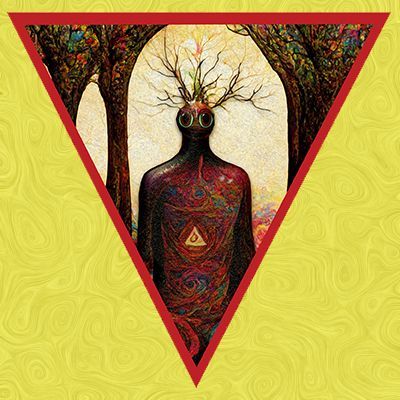
These beings lived in isolation for nearly five hundred years of The Interim. At the dawn of the formation of the Sagas in the last century of The Interim, a community living in the Medebe Regional Tree in the Northwest corner of the continent created many of these beings living in close proximity. Their location was already notable, known as the Ring Lakes. This formation was caused by a colossal Eye of Nu crashing at this site in prehistoric times, creating an artful arrangement of rivers and lakes forming a circular pattern. These combined tree beings were established in large numbers within these picturesque formations.
Ironically, given their distaste for much of the history and culture of the Tolku, they named these hybrids, particularly within this encirclement, Wajah. This was the most-ancient Tolku benediction among certain Lesser Era religions. Brought together, they grew in power and ability and came to symbolize the wisdom of the Viracocha Yakku nation. Pictured here is an example of a typical depiction of the Wajah, not as they appear but as mystical Yakku bodies growing out of Anu and sprouting branches. These four images are classic examples of ‘Backwoods Art,’ although they were interpreted millennia later after the Koru and Danam Yelda finally learned about their existence and nature.
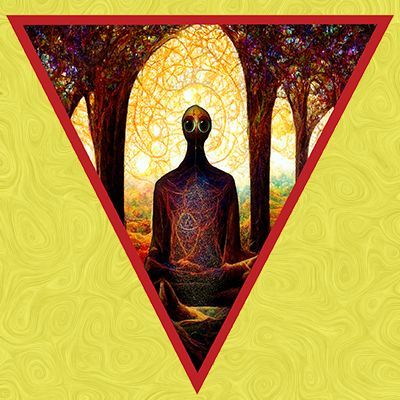
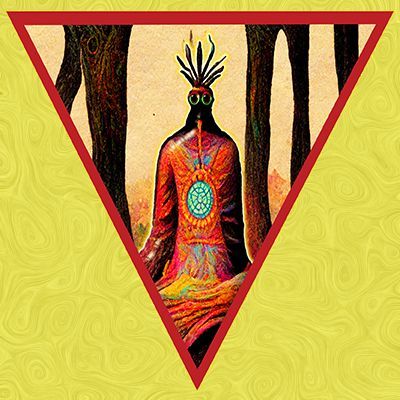
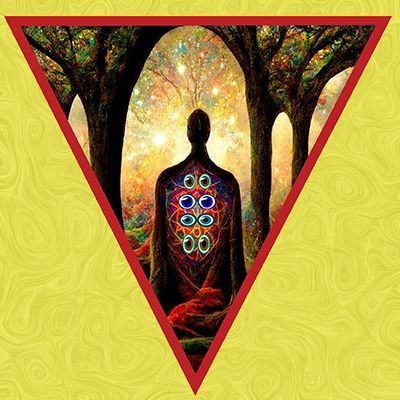
Nests and Levels
Within each of the Twenty-Three Regional Trees, there are anywhere between one hundred to five thousand Nests of varying sizes. (For many reasons, the larger populations have historically surrounded the central Viracocha Mountains, and the less populated Regional Trees have been along the northern coast of Thermistal.) These are interlinked community groupings of extended clans occupying one or more of the Eight Levels. While horizontal Mernet platforms characterize the gathering places of a given level or sub-level within or, occasionally, between the primary levels, the lifts, ladders, and other vertical modes of ascending and descending between levels are a significant element of all Nests. These horizontal platforms and vertical stairways dominate life within a Nest.
While there are many variations between Regional Trees, some traditions exist to configure the different levels and how Nests occupy them. The most complex of these are those Nests occupying the Eighth Level. This is partly due to the Foremost Moval’s residence and supporting nests. This is outlined immediately below (Crown Rises). The leadership of all other levels also dwells at this level. In doing so, they are in regular contact with all other Nests and are responsible for all aspects of direction and governance throughout the Regional Tree and beyond.
By Year 46 of The Interim, all Twenty-Three Regional Trees were formally instituted, each with its series of Crown Rises. This establishment preceded the colonization of the Regional Tree. The tree engineers created the Crown Rise, and the government and bureaucracy moved into it. A gradual influx of emigrating clans formed the remainder of the Regional Tree society.
Crown Rises
These are the engineered stands of immense Mernet, and other mighty trees are integrated into an intricate physical network serving each Regional Tree's administration, commerce, and governance. Usually, the Foremost Moval Nest is the most extensive of this network. In the more magnificent Regional Trees, several Movals are overseen by one Foremost Moval. This network forms the core of most urban centres. Most of what would be expected to be found in a capital is present within these intensely developed areas. This includes government, law courts, commercial centres, higher educational institutions and cultural venues. They became magnets for highly specialized practitioners of a spectrum of skills and abilities necessary for an increasingly complex society.
This coalescence of political and social order represents a modified version of the military organization of the Tolku Viracocha District Flora Ministry after The Killing Swath. Surprisingly, a far more ancient source was also employed to establish a vital branch of the Yakku Collective. The Funomanru Code (named after the first of the most-ancient pre-Tatchlan unifying dynasties of the same name) was preserved within the Flora Ministry’s libraries. It was drawn on to form the foundation of a clear legal framework for the Judicial Hand of Service in civil and criminal cases within the Twenty-Three Regional Trees. The formation of these Nests and Crown Rises and a growing division between these increasingly sophisticated urban centres and the majority living in the deep forests contained a seed of profound civil unrest to come.
This map shows the general distribution of the Twenty-Three Regional Trees of the Yakku Viracocha Collective in the western portion of the continent of Thermistal. These are nearly identical in extent and dimensions to the original twenty-three Estates of the Tolku’s Viracocha District Flora Ministry during the Greater Era of the Primary Epoch.
In this year; the first Koru explorers sailed across the Panchala Sea to survey the southern coast of Thermistal. They did so at night because this increasingly was their preference, and the Suvuka were profoundly diurnal. They quickly found evidence of the Suvuka reigning supreme on either coast of Thamuka Bay and to the East. Still, west of Merchelan Bay, they found signs of another intelligent force they did not recognize.
The Koru landed on Cape Chimen and met a scouting party of Yakku at dawn. Despite how very differently The Killing Swath sculpted them, each recognized their deep kinship to the other. What followed was a celebration of both Thermistal and Rho-Jashun. The two halves of the former Tolku were reunited. Extensive exchanges occurred, with groups travelling to the other nation to explore, learn, share, and return with unique gifts. The Koru suffered to ascend briefly into the canopy, and the Yakku did the same to descend into the mountains.
Formal historical colloquies were held, and specialized knowledge imparted. Gifts, small and great, were exchanged. These were so numerous and wide-ranging that a comprehensive account was challenging. One small example would be the Koru gift of the Tuchus Vine to the Yakku. This would become so ubiquitous within all Eight Levels that their Koru origins are mostly unknown to the current Yakku population. The fact this vine was related to a native species that was imported from Thermistal at the dawn of the Greater Era appears to have no reference in the Viracocha Flora Ministry archives. This period's most enduring legacy was the birth of a new species. Couplings between Yakku and Koru surprised both by producing offspring appearing to be a perfect hybrid. They named these children Yelda. This progeny often led to Yakku leaving Thermistal to live permanently on Rho-Jashun, while some Koru did the same. In both cases, they brought their homes with them. The Yakku brought seeds and saplings of all their famed forests to plant in the few relatively safe valleys deep within the Mulungu Mountains. The Koru began excavating tunnels and chambers within the Viracocha Mountains.
Declaration of Regret over Suvuka
The Yakku made a formal Declaration of Regret for allowing the Suvuka to travel through their territory and successfully cross over to Rho-Jashun ninety years earlier. They had learned from the Koru how this group of some four thousand had reached the Huallapandu Headlands. There, they established themselves before beginning their attack and occupation of Rho-Jashun and, eventually, Statos-Vey. They now numbered in many hundreds of thousands and filled the Marachla Plain. Yakku and Koru shared all their lore about their common enemy. They agreed the Suvuka were implacable in their hatred for both descendants of the Tolku. The Suvuka displayed no willingness to make peace.
In Year 191 of the Interim, a complete settlement of Koru was established deep within the Viracocha Mountains. The Yakku requested this, wishing fewer Yakku to leave Thermistal to follow their Koru loves and their Yeldic children. This colony is given complete autonomy and is not subject to Yakku laws within their mountains. The Koru maintain good relations and strive to do many services for what is now termed the Yakku Collective. The growing population of Yelda increased on Thermistal and Rho-Jashun. What became known as the ‘Half Year Rite’ was established. This saw Yelda spending half the year within the Yakku Collective and half within the Koru Mountains. This led to many cultural developments. The seven Regional Trees lying east, west, and south of the Viracocha Range: Bithen, Tanabat, Minosuk, Jinilitha, Jutchno, Serpine, and Hooklu developed close ties to the Koru of the mountains. As a result, these regions became relatively prosperous over time and displayed marked Koru influences. The majority of Yelda residing in Viracocha dwelt within these seven regional trees. This novel situation brought many tangible benefits for the Yakku Collective and stimulated many branches of thought and creative endeavour. Both groups assisted each other with resources and weapons to continue to fight against their common enemy, the Suvuka. Movements even sprang up, promoting a ‘reunification’ of these two ‘halves’ of the most-ancient Tolku merging the two cultures into one planet-wide civilization. These were almost exclusively found within the seven regional trees closely tied to the Koru within the Viracocha Mountains.
Growing unease
Along with all these positive developments, there was growing unease among the Yakku. Part of this had to do with the notable wealth and increasing diversity of the seven regional trees directly associated with the Koru. A far more significant issue was philosophical. To the north of the Viracocha Range, there were growing concerns about the many pivotal disagreements. These primarily centred on ‘The Legacy’ of the Tolku, the Tatchlan System. Throughout The Interim, the leading thread of thinking within the Twenty-Three Regional Trees was that this aspect of the Tolku civilization had been a mistake. It was a common theme that the last Tolku Majastas unleashed The Killing Swath and that such fearful powers should never manifest again. When the ‘Final Tolku Proclamation’ was discovered confirming oblique materials within the Viracocha Flora Ministry patrimony (see the second novel of this series, ‘Amarel Mountain’), most Yakku rejected the Koru concept of the Killing Swath being a required ‘Rectification’ of Tatchlan, believing instead it revealed the toxic arrogance of the most-ancient Tolku. The notion of an entire civilization sacrificing itself for Tatchlan was now quietly called the ‘abhorrent doctrine.’
Beneath these concerns lay others rarely expressed openly. Many Yakku became intimidated by the Koru. They had mastery of many powers. They were deft in the conquest of most obstacles. Their works already dwarfed most of what the Yakku had prided themselves on. Without in any way contesting with the Yakku, it was clear the Koru surpassed them with ease. They openly prospered in doing many things which the Yakku disapproved of. This discomfort and these concerns remained in the background, but later developments would see them increase. In response to this changing climate, those Regional Trees fully supporting this Yakku/Koru alliance instituted a new entity known as the ‘Yeldic Newborns League.’ This served as a place for Yakku and Koru adults to celebrate their first-generation Yeldic children through a variety of ongoing resources and events to both provide support and to counter negative dialogues against the Koru in the larger Yakku Collective.
Challenging Legal Code changes
Within Yakku legal and academic associations, there was contending evidence to this growing anti-Tatchlan narrative. Early in The Interim period, the Viracocha Authority consulted their extensive ministry libraries to help formulate a new legal system for the emerging Yakku Collective. This extended process began in earnest after the defeat of the three Suvuka armies. Remarkably, they found a complete set of the Funomanru Code and the even larger Buyanupithar Code from pre-Tatchlan times. While the volumes were of far later construction, they were faithful renditions of the Thithanu editions once produced in the World City prior to the First Suvuka Onslaught of Rho-Jashun. The Yakku returned to these foundational documents as they predated the entire Cluster-of-Clusters National period of the Tolku’s Greater Era. While extensive modifications had to be made to numerous conventions given the Yakku’s different life and social structure, much could be brought forward with little amendment. This lengthy procedure was ongoing when the Yakku first learned of the existence of the Koru. Significant exchanges occurred between the two cultures in this area during The Happy Century.
Along with many other discordant issues, it became apparent that crimes of all classes existed to a far greater extent within the Yakku collective. Even without a Majastas, the Koru’s Central Triumvirate appeared far less troubled by aberrant social behaviour. When criminal activity occurred, it was often determined that mental illness was the cause. As had been the case for the Tolku of the Greater Era, civil issues predominated in legal cases. During the rest of The Interim, the Yakku observed an apparent diminishment even in these cases, with the development of Healing Vats and other treatments reducing the incidents of criminal activity. This situation took a dramatic turn with the arrival of the Koru’s first Majastas, Zudaz I, at the beginning of the Secondary Epoch. Almost immediately, all criminal disturbance ceased with the emergence of the whole Cluster-of-Clusters Nation on Rho-Jashun, based on a fully integrated population living with the full suite of the Spokes of the Cluster Wheel.
The undeniable evidence of this remarkable development, examined by the Yakku Collective’s professional classes in regular contact with the Koru, led to most Yakku elites revising their thinking. While many of the educated had already reached this conclusion, more now conceded that their rising crime rates compared unfavourably with the life enjoyed by the Koru. Leaders in artistic fields also appear to have been moved by this and other inconvenient facts and began to dissent from the anti-Tatchlan threads of their Yakku account. Even among the Siv-Sa religion’s ‘Four Schools,’ this demonstrated reality had an impact. The Miming Academy came the closest to suggesting that the Koru Cluster-of-Clusters Nation was to be learned from and even emulated.
All these informed and enlightened trends were no match for the raw emotion and general ignorance of the populace, especially outside the Crown Rises. In the backforest, centuries of whispered fears were finally given form by the false narratives of the Djingal Votary, which made them feel safe, meaningful, and in possession of secret knowledge that cancelled these otherwise troubling facts. These contending versions of ‘truth’ led to a growing polarization between several linked classes within Yakku society. This became fully realized when Majastas Zudaz I conducted a Progress to the Yakku capital of Gye Sonin in the Yakku Regional Tree of Bithen in 150 UKC. From this point onward, the battle lines were drawn in an ongoing undeclared civil war between those supporting ties with the Koru and those opposed. Despite their many abilities and advantages, the Crown Rise elites were mistaken to deride and dismiss the influence of Siv-Sa among the simple. They also appear to have been blind to the long-range plan of the Djingal Votary to infiltrate various institutions, particularly education. By increments, they gradually sowed seeds of suspicion and fear of the Koru among the general population. The stage was set for one event to ignite a cultural wildfire.
Partial travel bans
In the Year 322 of The Interim, migrations of Yakku to Rho-Jashun are declared illegal by eleven of the twenty-three Regional Trees. They were Chimatal, Indenam, Chikohet, Bosatem, Thirim, Gnampo, Kune, Medebe, Watejas, Izanaki, Wakahik, and Shinda. These Regional Trees formed an outer band to the east, north, and west, around the inner regional trees in contact with the Viracocha Mountains and the Koru. After a century, the ban was lifted by nine of the Regional Trees, leaving only Watejas and Medebe. Still, the action highlighted the growing divisions within the Yakku Collective over the presence and role of the Koru on Thermistal. What follows is an extended examination of a religion known as Siv-Sa, which was based primarily on this anti-Koru sentiment.
Triplet's abilities
Triplets were born within Watejas Regional Tree, just south of the Tvirteyak River that feeds the Ring Lakes in the Year 721 of The Interim. Their names were Idat, Viry and Hita. From a young age, these boys distinguished themselves in several ways, including an apparent ability to know each others’ thoughts without speaking or signing or at a distance. One would start a sentence, saying only a single word, and the next would say the following while the third said the next word. They would continue this for long periods, producing complete sentences in rapid succession to each other. What began as curiosity grew into awe among the growing crowds coming to witness this wonder. This awe quickly became fervour at the content of their recitations. From the start, these became mystic declarations that became increasingly hostile to the Koru and all they stood for. Later they began having visions.
Devotion and ‘thicket foolishness’
Pilgrims going to the Ring Lakes to see the Wajah began to add a new stop to their circuit. Once completing their devotions to the Wajah, they turned south to hear these three boys. This led to a growing following within Watejas Regional Tree, and new prosperity from the flood of visitors increasingly willing to pay to sit on nearby branches. Specialists from several Crown Rises observed the triples and agreed on their remarkable speaking abilities. Most authorities dismissed them as well-trained charlatans able to skillfully work the crowds already believing in their message, characterizing these events as ‘thicket foolishness.’ A famed report at the time that was highly critical of the triplets and their claims was titled ‘Backforest Magic.’
Satyrical songs
This was one of many popular songs sung at the time in the Crown Rises, illustrating the divergence of culture between urban and forest, north and south:
Our every remark
Is true and is real
Our words make you happy
Our visions they heal
We never sleep and
We never stop dreaming
All trees are one and
All birds have their meaning
We have such headaches!
Those Koru we blame!
They muddy our hands and
Cause us to shame
Do not look close!
Do not ask why!
Float up with us
Into the sky!
Long after their deaths, the above symbolic portrait was fashioned. It shows three children's faces with huge eyes, exaggerated ears and no noses nestled in the ‘Eight Hands Formation.’ They appear to manifest within the dream-like Anu Tree realm (see below) and emit light from their mouths and bodies reflecting the light infusing all in this idealized domain of their visions. The Koru fashioned these Siv-Sa images at a much later date to all others near the end of formal relations between the Koru Cluster-of-Clusters Nation and the Yakku Viracocha Collective. The green geometry of their borders notes their distinct nature. Siv-Sa did not exist at the time of all the other Interim emblems depicted here.
Anu Tree
Their visions took the form of finding themselves on a massive ‘world tree,’ which they named the Anu Tree. They would fall into a trance and wake on this tree, where animals told them about the tree linking Anu to their sun, Nu. They climbed to the top of the Anu Tree to find an immense bird perched on its crown. His name was Virochula. He wore blazing Nu as a diadem on his head. Nu’s rays shot out in a starburst pattern around his radiant body. He had a ring of dead white serpents around his neck and a knot of them across his breast. When Virochula flapped its rainbow wings, he caused the Eleven Winds.
Virochula taught them many things. He said Nu atop his head was trapped and could not do what he desired most: purify Anu. They said Virochula’s head feathers were singed from holding Nu prisoner. Nu escapes on occasion and sends fire arrows into the forest during storms. Virochula is ever losing and recapturing him while growing new feathers to hold him. Virochula also said his body was the embodiment of all birds. The Anu Tree was the ‘collective flesh’ of all trees.
He said that after paying proper obeisance to him each time they came, they were changed to travel down and over each branch, learning from the animals that dwelt there.
This image depicts the Anu Tree, with foliage filled with the eyes of the many marvellous beasts inhabiting it. Virochula appears as a pair of wings at the tree's crown, separating Nu from all below it. The four moons and six stars fill the sky. Below the four levels of foliage, the trunk is composed of the ‘four-hands’ formation enlivened with a pair of Yakku eyes. These hands appear to wield weapons focused on a few white worms on the lower trunk—more on the significance of these white worms below.
Animal Songs
What later would become the Siv-Sa Sagas are divided into sections not arranged chronologically but from the smallest to the largest text on a theme. One of the early chapters is named the ‘Animal Songs.’ This is considered the oldest and least edited part of the canon. These fantastic and often delightful tales tell of the triplet’s visits to each animal inhabiting the Anu Tree. Like all else, each being was the composite for all of their kind on Anu. While there are many different elements, all agree that Virochula loves the Yakku. He represents the best voice of Anu in his constant debate with the imprisoned Nu against the purification of Anu. Later, some sympathetic commentaries found many layers of sophistication beneath the surface of these tales, while others dispute their existence in anyone but these commentators’ minds. They pointed out all the insights ascribed to the Animal Songs came from diverse and ancient sources independent of this work. There are far older Yakku sagas about world trees and enchanted birds living in them. The one undercurrent all could agree on were warnings about what we would call the Burning Blossom.
Purity of the air
This was a dominant theme in over half of the works collected in the Siv-Sa Sagas. The concept is one of the air being the final state of purity all life aspires to. Many images of growing ever lighter in weight and ever more translucent in form illustrate these concepts. There are several stories about how all creatures aspire to become birds. The birds, in turn, spoke about how they wanted to become winged insects. These, in turn, wished to become the Gandahatapan, also known as the ‘Perfection of the Air.’ In these works, the Gandahatapan has none of its vibrant colourings but is nearly translucent, its characteristic call merging with the sounds of the wind. One song speaks of gossamer Gandahatapan filling the air surrounding the Anu Tree. Urban critics were fond of pointing out a historical inconsistency in this doctrine. The most-ancient Uluvatu Tatchlan Masters saw the Gandahatapan as one of the inspirations for what these triplets saw as the ultimate anathema, the Tatchlan System.
Sampling of Siv-Sa chants
The following are two examples of chants and songs developed during this period. They appear to have been intended to be declared by large groups and meant to echo through the trees. While regional variations exist for both examples, most conform to this text.
The following simple composition was meant to be chanted repeatedly in large gatherings.
What is below is foul.
Defeat it!
What is below is wicked.
Defeat it!
What is below is poison.
Defeat it!
What is below is evil.
Defeat it!
Triplets criticize Body Mysticism
In their tenth year, in 731 of the Interim, the triplets began speaking about what they saw as the perversion of feeding the dead to trees, including the Bowvow Tree. This caused great difficulty for many of their followers. This was not only because the practise was universal but also due to the ongoing reverence paid to Bowvow Trees and the Wajah, which themselves were a merger of Bowvow and Yakku. The bonding of Yakku flesh with the flesh of trees was often seen within all previous pious Sagas, which was one of the ultimate aspirations of every Yakku. Theologians spun elaborate discourses on how these two teachings were not, in fact, in conflict with each other. This was one of many contradictions, and they set themselves on harmonizing. This, in turn, inspired many of the spoofs and parodies that became very popular in the Crown Rises. Soon after, these problematic texts were edited out of the Siv-Sa Sagas, while the older versions were declared heretical fabrications. This led to the hoarding of these earlier texts by academics and collectors. The newly approved version was renamed the White Hand Saga.
Hanging the dead
Despite the playwrights’ and scholars’ mockery and the growing Siv-Sa priesthood’s later removal of these texts from the canon, the ‘backforest’ Yakku came to honour their words in unforeseen ways. A famous phrase from these excised texts was remembered, ‘he is free of Anu and floats to Nu.’ It led to a new practice of hanging their dead high in trees. The triplets never taught this or promoted it by their high-eschaton followers; it became common in several Regional Trees, particularly those of the North, including Thirim, Bosatem, and Kune. They describe them as Virochula Offerings, referring to the great bird atop the Anu Tree. Feeding their dead to Virochula’s multitude of aerial servants brought about incorporation into Virochula’s glorious sky-bathing and Nu-adorned body.
This observance involves firmly encasing the body in a robust wooden frame ‘suit,' keeping it in an ‘attentive’ posture. Notwithstanding predation, the arms remain at the side and the legs together while the head is kept upright until naught but bones remain. These practices appear to align with an intense devotion to Virochula and an often vibrant ‘backwoods’ artistic tradition, particularly in the form of Virochula images being grown in Mernet Trees, throughout the North. Unlike most other types of devotion, there is a division within the Siv-Sa community over this ‘sky death’ practice, with few, if any, of the faithful following this further south. It also incurred the ire of the authorities and led to legal sanctions against this custom.
Dark visions
The Body Mysticism controversy, particularly the resulting ridicule from playwrights and comics, seems to have severely affected the triplets. They also struggled with their followers acting in ways they could not control, editing, and changing their Sagas. When they heard a new version of their collected sayings had excluded their condemnation of Body Mysticism, they withdrew into the backforest of Watejas Regional Tree. Their followers formed protective rings around their high residence and allowed none but the most faithful to approach them. They had grown into adults, and when they broke their silence and spoke in their distinctive fashion again, their visions had darkened. Their final set of visions before their untimely end came to be known as the White Hand Saga, which in time would become the name of the entire collection.
White Worms
This White Hand Saga was completed in the Year 740 of the Interim and was the most dramatic and famous. It is also the longest and possesses a literary quality lacking from the earlier parts of the collection. It stands at the opposite pole to the ‘Animal Songs’ of nearly twenty years earlier. The White Hand begins with Virochula instructing the adult triplets to climb down to the base of the Anu Tree.
They had never done this before, always moving out and up. They did so because all the Anu Tree denizens had grown frightened at incidents of the Anu Tree shaking. The triplets made their way down; the further they went, the darker and more frightening it became. When they finally reached the bottom, they found substantial white worms curled around the trunk and more coming out of yawning holes in the ground. These worms had large white hands where their heads should have been.
Their flesh was the colour of dead bones, but shook like blubber and smelled foul. The saga describes a multitude of loathsome underground creatures crawling all over these pale forms. Despite their flaccid appearance, they are immediately roused and darted up like snakes to grab the triplets. The boys took out knives and stabbed the large pasty white hands. More kept rising, and their blades stuck in the hands and would not come out. Black blood flowed from the wounded white hands as they continued to grab at them. The blood was as the black issue of Anu; it stank and caught fire under Nu’s wholesome glare. The White Hands also repeatedly slapped the trunk. Since their girth was half as considerable as the Anu Tree, this slapping shook the Anu Tree violently and nearly dislodged them. The triplets were forced to retreat up the trunk beyond their reach, slowly followed by the White Hand worms slithering after them.
Even the dullest audience immediately realized these creatures represented the Koru with their well known White Hand Icon. While not explicitly mentioned in the Saga, tradition has always had these hands closely associated with the Ketukku. The Yakku Collective always shunned these insect societies. They did so for their deep association with the Koru and the most-ancient Tolku Masters, and for any harm they presented to their forests. The above representation shows how often the eight classes of Ketukku society appear covering these White Hands.
White Hand battle
This skirmish precedes an epic struggle between the noble tree dwellers and the ignoble White Hands. Many stories depicted in gruesome detail the torture and death of each animal of the tree. The White Hands squashed some, tore others apart and poisoned others. Their fingernails turned black with venom before they scratched their victims. Eventually, when all appeared lost and only the triplets remained, Virochula flew down and burned the White Hands with the light and heat of Nu on his head. Hundreds turned into fireballs that hurtled down to the ground while others were consumed where they hung. A few White Hands escaped by crawling back down into their dark holes. Beyond the epic narrative, there were many dialogues within this White Hand Saga. They left no room for doubt that the hands represented the Koru and labelling them the ‘poison of Anu’ all Yakku must drive from Thermistal. Given the White Hand was the known symbol of the Koru for themselves, this was quite clear. Sometimes, the most-ancient Tolku were also named enemies, and the Koru were called their ‘vile spawn.’ Terms like ‘reject the legacy’ appeared for the first time in this White Hand Saga.
Triplet's death at the Ring Lakes
The White Hand Saga was completed in 741, the last year of The Interim and twentieth year of the Triplets. They crossed the Tvirteyak River into Medebe Regional Tree. It is here the famed Ring Lakes are found. They wished to recite this White Hand Saga directly at the August Assembly of Wajah. The Saga had begun to spread across all twenty-three Regional Trees, causing significant discord and contention between different classes within the Yakku Collective. It was best received amongst ‘backforest’ communities far from the Crown Rises, creating a swell of piety and worship for the triplets. This was most potent in their own Watejas Regional Tree and the neighbouring Medebe, home of the Swaying Ones. Perhaps due to these controversies, the triplets were not permitted to gain close access. They had to be content with a distant audience high in an old Mernet Tree whose large branches extended all directions, including over the fast-flowing Praka River. From there, they could see and hear several vast Wajah on the other side of the riverbank. They assembled there along with fifty devotees. They began to sing the tale about the vile White Hands in their characteristic fashion. Only partway through their recital, the bow they were all standing on broke, and the entire group fell into the river. The Praka River is mighty at this point, having issued out of the depths of the Ring Lakes and only begun its long journey east and north to the Tharapura Ocean. Despite desperate attempts to rescue the group, only twenty-one were successfully pulled alive from the frigid waters. Such was the swift and deep currents of Praka that the triplets’ bodies, along with twenty-nine other unfortunates, were not recovered until the next day, several andas from the accident.
Triplet's death linked to first Koru Majastas
Amidst the initial mourning and later consternation and accusations, the fame of the triplets grew. Both devout and skeptical, Yakku and Koru, agree that the death of the triplets happened near when the first Koru Majastas, Zudaz-Vozev, manifested within Mount Chraxan on Rho-Jashun. She was ‘nine and twenty’ years of age. This heralded the end of the period known as The Interim in its Year 741 and marked Year One of the Secondary Epoch. The Yakku and Koru met in Year 178 of the Interim. In 191, the Koru colony was established at the core of the Viracocha Mountains. Yakku and Koru lived on Thermistal together for five hundred and fifty years. Now, the Koru had a Majastas, as the most-ancient Tolku had throughout the Primary Epoch. The devout Yakku believed the triplet's death and the Majastas emergence occurred at the same instant, and the two events were linked. The date and time of the new Majastas receiving the Mantle are a matter of record. Honoured Historians agree they died early in Year One of the Secondary Epoch. They dispute this claim of the triplets dying on the same day, let alone the same hour. Another story persisted for which there was no evidence, and none of the original witnesses' testimony was confirmed. It went that initially, only Viry drowned, but the other two, Idat and Hita, survived. Despite this, when they saw the body of Viry, they threw themselves back into the river as neither could think of life without him.
Four Schools
This religion was initially confined to the northern Regional Trees of Watejas, Medebe and Dinich. The first century after their death saw very little growth in their movement beyond the backforests of these northern regions. Then, some unlikely converts from several Crown Rises within Watejas and Medebe Regional Trees began organizing the faithful. This is characterized as ‘unlikely’ as until now, Siv-Sa had little success attracting an urban audience. These more cultivated groups founded several schools of interpretation of the sagas, known as the ‘Aizen,’ ‘Sif,’ ’Djingal,’ and ‘Miming,’ all founded between the Years 60 and 130 of the Secondary Epoch.
The Aizen Coterie, was founded first in the Year 60 of the Secondary Epoch by the living relations of the triplets. They already enjoyed near royal status within portions of Watejas Regional Tree. This school also possessed a large body of secondary material about the life and words of the Triplets not included in the Sagas. This collection was known as the ‘Day to Day Anthology.’ They also had original portraits of the Triplets and other personal and historical artifacts that became increasingly important to the devout. They were also the keepers of the Bowvow Tree where they were fed after their death. This traditional disposition of their bodies was seen as a first step in building the new religion.
The Coterie emblem shows the Yakku hands spread over the most-ancient image of one of the four Grand Menem, Vindaviran, known as ‘The Teacher.’ This is another sign that the Yakku possessed a considerable legacy of Primary Epoch literature. As joint inheritors with the Koru, they utilized its archaic iconography for new purposes. Another most-ancient image that appears here is that of the Haklu, a stringed musical instrument meant to symbolize the Coterie’s devotion to refinement and culture.
The Coterie also distinguished themselves by securing copies of the most-ancient Tatchlan critic Nebutan ’s three publications, the ‘Rise of Tatchlan,’ ‘Worse than Chaos,’ and ‘Dignity’s Demise,’ along with the later ‘Collected Letters.’ Honoured Koru Historians marvelled that such relatively obscure and antique literature would have survived within the original Viracocha District Flora Ministry of the Primary Epoch. These works were recovered during The Interim, and the Aizen Coterie now republished them. This caused considerable discussion and debate within academia and others residing within the Crown Rises of each Regional Tree. The Aizen Coterie was the most cultural of these new movements. Among other things, it promoted a set of aesthetics for cultivating Mernet Trees and specialized Mernet Ball augmentation. This was intended to assist with nest organization in harmony with its interpretation of the Sagas. While urging Yakku to live faithful lives in the canopy, they were pragmatic regarding the Koru, promoting extensive trading relations with them.
The Sif Discipline became formalized in Year 86 of the Secondary Epoch. This school was partly founded to counter what some felt to be the decadent excesses of the Aizen Coterie. They fashioned a profound mysticism and set up specialized communities and institutions to practice austerities thought to emulate the observed visionary exercises of the Triplets.
These centred on retreats where intensive practices led to a dawning of awareness and visions. Sif Discipline adherents were known for simple attire and often singular forms of discipline, usually practiced in isolation or small groups away from populated areas. This school had nothing to say about the Koru.
The recognized Sif emblem displays a Xumkuka, long a symbol of health, purity and simplicity among the Yakku, carrying a ‘Double Hand’ formation. This suggests something in flight, upward into the clear air. This is one of the rare occasions where non-followers fashioned the symbol of a movement, given that Sif never deigned to craft one of themselves.
The Djingal Votary was founded in Year 116 of the Secondary Epoch. They also condemned the Aizen Coterie as corrupt and immoral. They criticized the Sif Discipline as elitist and isolationist. Djingal was the most activist of all these schools, focusing on transforming Yakku society. Based on the sagas, they developed a strict moral code and rudimentary legal system for those inside their communities. They were known for proselytizing and attempting to alter education curricula by gradually entering various professions to bring about social change. They also produced simplified versions of the Sagas, drama, and art appealing to the less educated backforest dwellers. Unlike the other schools, Djingal preached extreme intolerance towards the Koru, wanting them banished from all Thermistal. Another aspect of this school was the high regard they held for the Swaying Wajah of the Ring Lakes. They developed good relations with those attending the Wajah. They patronized those adept at interpreting the Wajah’s ‘august rumblings,’ which were often difficult to understand.
Given the Aizen Coterie’s emphasis on tradition and culture, it would have been assumed they would have formed this link. Because of the tale of the Triplet's death being caused by being forced onto a weakened bough, the Aizen Coterie omitted the Swaying Wajah from their regimen. The Djingal Votary’s enthusiasm for the Wajah may thus be seen in part as a deliberate slight of the Aizen Coterie.
Their emblem shows four traditional symbols of the Suvuka war pointing downward, as if towards the Koru. Each appears guided by the Mahakram society emblem as the ‘Wise Spider Glyph.’ These weapons are governed by the three classes of Yakku Cousins, as directed by a luminous and glowing trio of the Triplets, nestled in a ‘Four Hand’ formation. The living forces of the pure air, the Kumastam and the Gandahatapan, are meant to be seen here as guardians of Siv-Sa, capable of defence and attack against all opponents.
The Miming Academy was founded last in Year 130 of the Secondary Epoch. Unlike the Sif Discipline and Djingal Votary, they had no issue with the Aizen Coterie. They established a cordial relationship with their hereditary leadership. As their name suggests, Miming was an educational and scholarly movement. Over time, they gained access to all the historical material held by the Aizen Coterie. They worked to fashion a cohesive set of ideas based on the Triplet’s thousands of written words, both from the Sagas and the lesser-known and far more significant ‘Day to Day Anthology.’ They reached out to the leadership of the Sif Discipline to gain insight into many of their practices, which they knew were based on actual disciplines of the Triplets. They also established relations with the Koru and enthusiastically travelled to Rho-Jashun to study in the vast libraries and museums within the Mulungu Mountains. Representatives of the Miming Academy exchanged collections of works generated within the Yakku Collective. They brought back Koru libraries to donate to various Yakku institutions, including their partners in the Aizen Coterie. They attended seminars and lectures on Rho-Jashun and, in time, hosted their own.
The result was the cultivation of a distinctive moral philosophy far more sophisticated than the original Sagas. The one school they would not deal with was the Djingal Votary, whom they characterized as pandering to widespread ignorance and of being power-hungry. Given the subsequent history, their emblem is remarkable. Against a dynamic backdrop, a smooth and pure green Yakku hand extends to the pages of a book symbolically containing both the legacy of the most-ancient Tolku and the Koru. With the later triumph of the Djingal Votary, such images and all aspects of the Miming Academy were systematically wiped out.
After more than two decades in preparation, in Year 150 of the Secondary Epoch, the Aizen Coterie published a new version of the Sagas. In their archives were many sets of this material, all written initially after the triplet's death and diverging significantly from each other. In 150, the Aizen Sagas were published to produce a definitive version based on drawing together most texts and choosing to select the more artful passages. They also decided to include additional material from their ‘Day to Day’ collection, although this was separated from the Sagas portion of the book. While known as the ‘Aizen Sagas,’ this was a joint venture between the Aizen Coterie and Miming Academy. They pooled their resources due to the increasing popularity of their shared rival, the Djingal Votary. The Votary was meeting with increased success in followers and influence. To understand the adverse reaction to this document, we must move to another event happening in the same year.
Koru Majastas Zudaz I travels to Thermistal
In Year 150 of the Secondary Epoch, the seven-hundredth anniversary year of theKoru being welcomed to settle within the Viracocha Mountains of Thermistal, the Koru Majastas Zudaz I travelled to Thermistal on the newly-completed Viracocha Line, a branch of the Thermistal Continental Line. All Movals of the twenty-three Regional Trees were informed a year before the event. They were invited to attend ceremonies that would take place in Gye Sonin, the Crown Rise Capital of Bithen Regional Tree, on the Western Spur of the Viracocha Mountains. Twenty Regional Trees did send their Movals or close representatives; Medebe, Kune and Gnampo did not.
Majastas Zudaz I, also named Zudaz-Vozev, first toured the extensive network within the Viracocha Mountains before emerging to meet the Yakku. She climbed the tallest Mernet Tree at the centre of the Foremost Moval’s Crown Rise to tour the wonders of the Yakku capital of Gye Sonin. She met with government officials, cultural leaders, and thousands throughout the arboreal metropolis. It is said all who just saw her at a distance were transformed. She brought a large number of Koru Ministry representatives along with a considerable entourage of notable Koru representing a cross-section of Her emerging Cluster-of-Clusters Nation. A special ceremony honoured her for sterilizing the Suvuka of Rho-Jashun (see below). All documentation of the time agreed this was a momentous occasion for all those in Bithen Regional Tree.
Reaction outside of Bithen
When the Majastas Progress was completed and Majastas Zudaz I had returned to Rho-Jashun, hundreds of guests began returning to their Regional Trees with tales of delight and wonder. All those seeing them agreed they had undergone a mighty change. They brought commemorative mementoes representing an unimagined level of artistry. They offered collections of drama, literature and music representing a deep and rich culture. All of this was welcomed enthusiastically in most of the urban centres. Professions and guilds were inundated with marvellous innovations to enrich their endeavours. The Miming Academy was also very moved by this event. Most of their members travelled to Bithen Regional Tree and returned with bold predictions of a new era in Yakku /Koru relations. Mioyanri Sujin, the Crown Rise Capital of Watejas Regional Tree, witnessed an assembly to present lavish gifts from the Koru Majastas to the Aizen Coterie. At this gathering, the formal launch of the Aizen Sagas was announced, and the collection became available across the Yakku Nation of Viracocha.
Wajah divisions
The second wave of returnees now swept across the Yakku Collective, this time from the Ring Lakes. The Aizen Sagas were enjoying a wide circulation and were receiving praise from many quarters. The prestige of the Aizen and Miming community rose through the upper levels of the Yakku Collective. Then rumours began to spread about the Swaying Wajah’s terrible prophecies. Members of the Djingal Votary and their supporters reappeared in the Crown Rises and issued statements of what happened at the Ring Lakes. They included claims the Wajah had condemned the Koru, Aizen Coterie, and Miming Academy. Surviving witness accounts of those Wajah admonitions by those not associated with the Djingal do not include these specific condemnations of the Aizen and Miming. The stage was set for conflict, but nothing happened beyond verbal contention. This was because most regional nests' Foremost and Prime Movals moved swiftly to counter these dissenting voices by various means.
The Academic community spoke with one voice against these pronouncements. Some questioned their accuracy; others voiced well-established doubts about the nature of Wajah declarations. One volume was issued within a year detailing a vast inventory of Wajah dictums and the verified facts contradicting them. Twelve leading authorities in various disciplines surrounding Wajah studies authored the text. Another group added their voice. The majority of artists united in producing celebrated satires against the often absurd and conflicting messages from the Wajah and the authoritarian and stupefying messages of the Djingal Votary. Several musical comedies enjoyed great acclaim, and their lyrics were sung throughout the collective. These and other voices successfully blunted the impact of the Djingal Votary’s campaign to capitalize on the Wajah forecasts.
Yet, while not evident then, the Djingal Votary were, with patience and persistence, beginning to turn the tide. Despite many voicing doubts and even heaping musical scorn about the ‘Wajah Warnings’ and the seemingly unassailable respect and position of the Aizen Coterie and Miming Academy enjoyed within the upper strata of Yakku society, Honoured Historians may now trace the roots of their downfall to this period.
All of these developments took place on Thermistal despite the ongoing presence of the Suvuka hordes just east of the Silvasora Mountains. Minor invasions continued on all fronts on a cyclical basis. Occasionally, a single Yakku or small group would be surprised by a roving pack of Suvuka on the borders of the five easternmost Regional Trees. Notwithstanding the passage of time, the Suvuka showed no sign of releasing their hostility towards what they appeared to see as new versions of their hated foe, the Tolku. Those Suvuka on Rho-Jashun and Statos-Vey seemed possessed of the same determination to exterminate all descendants of their most-ancient enemy.
Various speculations were made as to the reasons behind this undying hatred. Some thought the Suvuka believed they had the right to be masters of Anu. Others suggested they retained their primordial adoration of Hesha Vira, the Face of Raw Life. They suggest the Suvuka still wished to liberate her from the Tatchlan System. It was also proposed they would never forgive the Tolku and their descendants for their role in altering life on Anu.
Eighty-six years before She came to Thermistal, in Year 64 of the Secondary Epoch, Majastas Zudaz I rediscovered and released the weapon of the most-ancient Tolku Tatchlan Master Duamang.
“Our history dictates we must expunge Anu of our former companion, ally and nemesis.”
She declared at the time. This ‘release’ took form both inside the Living System of Tatchlan and outside on the Skin of Anu. The ‘weapon’ is a tiny colony based on the once dreaded Brangnam Plague requiring only a slight modification to perform its service in stopping the fertility of Suvuka. The adjustment was temporary and occurred within the Living System; the physical ‘release’ was primarily symbolic.
All Foremost Movals of the Yakku Collective of Viracocha knew of this development. News of the action swiftly spread through all the Regional Trees. Thirty-four years later, in Year 98 of the Secondary Epoch, the Yakku were informed no new Suvuka cubs were born anywhere throughout Rho-Jashun or Statos-Vey. Majastas Zudaz I told the Yakku Movals She would wait to ensure all Suvuka were extinct on Rho-Jashun and Statos-Vey. Once confirmed, they would be monitored on Thermistal to see if a second application was required or if Master Duamang’s weapon would cross the Panchala Sea of its own accord. She said this would be preferred for various reasons concerning the Living System of Tatchlan.
Crisis of confidence
While the Yakku were relieved to learn of the Suvuka's impending doom, this action also fed a growing unease. While muted within the Crown Rises and commercial hubs, where the Suvuka’s fate was widely celebrated and the Koru genius lauded, these misgivings continued to grow. Once again, the Koru and their Majastas accomplished what the Yakku could not. For all their strength and glory, the Yakku could do nothing but wait and see if a weapon none of them understood would strike the wombs of the Suvuka of Thermistal.
Suvuka retreat to Thermistal
After realizing their fate, the Suvuka of Statos-Vey and Rho-Jashun migrated towards the Huallapandu Headlands in Northern Rho-Jashun. This was where their distant ancestors successfully crossed over from Thermistal for their First and Second Onslaught of the South. While most chose to remain and die there, a small number tried to migrate back across the Panchala Sea to reach their ancestral homeland. Few survived the crossing, and the Yakku mostly killed those who did. A handful are thought to have reached the Lake Teval Basin and inform the rest of their doom. Observers noted these pitiful survivors were slaughtered shortly after their arrival by the Thermistal Suvuka. This was carried out by a few, who then moved south, away from the rest, never to return. It is speculated that once the Suvuka heard what happened on Rho-Jashun and Statos-Vey, they feared these few brought contagion.
Suvuka weakened
In the Year 200 of the Secondary Epoch, the Suvuka were completely extinct on Rho-Jashun and Statos-Vey. This had lead to the full emergence of the Koru on Rho-Jashun, although they only ventured out at night. This also signalled the first dispersal of what would come to be known as ‘Field Yelda’ from the shelter of the Royran Valley, fuelled by the employment of the rare ‘Spice Driver,’ out onto the Marachla Plain. Thousands of Yakku joined these first Yeldic clusters, descendants of those who colonized the Marachla Plain centuries earlier. These generations of Rho-Jashun Yakku had also been sheltered in hidden forest valleys within the Mulungu Mountains. They now began their migration to settle in Estates established across the newly liberated Marachla Plain.
Unfortunately for Thermistal, the Suvuka were still present in large numbers east of the Silvasora Mountains. A lethargy was detected among the Suvuka hordes around Lake Teval since the release of the sterilizing agent one hundred and thirty-six years before. The rare Koru Operants and Invocates able to track them within Tatchlan reported they had been affected by a weakened form of the agent but were still fertile. Yakku and Koru observers within the Silvasora Mountains of the Lake Teval Basin confirmed this. They noted a diminishment in the size and power of adults since that time but that the young were still being produced in sufficient numbers to warrant a separate dispersal.
Fifty years later Majastas Zudaz I returned
In Year 200 of the Secondary Epoch, Majastas Zudaz I quietly travelled to the Silvasora Mountains via another branch of the Thermistal Continental Line. Deep within the mountains, She ascended to an Eye Station near the frigid peak of Mount Vilsanda, the highest in the Silvasora Mountain chain, to release the weapon. In doing so, She mirrored the most-ancient Tatchlan Master Duamang, who had set loose the dose from an observation post high in Mount Anchaphron within the Mulungu Mountain Chain. This is now District Seven, the Chraxan District, of the Koru Cluster-of-Clusters Nation. The Mount Vilsanda release was symbolic, as few of the tiny beings would survive the altitude. The prevailing western winds would take them in the wrong direction. Majastas Zudaz I released these modified beings at each Eye Station throughout the Silvasora Mountain chain bordering the Lake Teval Basin.
She monitored their progress inside and outside of Tatchlan. She wished to ensure the dense population around the lake was sufficiently infected to ensure all Suvuka on Thermistal were doomed. What brought the First Suvuka Onslaught to an end before the emergence of the Greater Era of the Primary Epoch would now cause the final extinction of all Suvuka on Anu. Majastas Zudaz I declares the work will take several generations of Suvuka. Due to the majority of the population being concentrated in Central Thermistal, She deemed a century sufficient to bring about their end. She assured the Yakku Movals while it was slow. It was quite thorough, and the beasts would eventually die away of themselves.
Surprising Yakku response
Notwithstanding established communications between the Koru and Yakku, the popular reaction to this news surprised many. Public jubilations occurred in most Regional Trees, especially Chikohet, Indenam, Chimatal, Hooklu, Leyaku and Jutchno, being the easternmost Regional Trees and thus the most impacted by the Suvuka. An abundance of songs, poems and theatrical productions were fashioned to celebrate the history of the Yakku, their alliance with the Koru and the impending defeat of their common enemy. At the same time, there was a growing undercurrent of frustration. Some took the form of anger over the news of a far more extensive Koru population and infrastructure on Thermistal than was previously realized. While the Movals and governing elites had always known the Koru had settled all three mountain ranges, this fact became general knowledge. With the dispersal of the Duamang Weapon dispersal, maps displaying the Thermistal Continental Line travelling through the Silvasora Mountains, and the locations of Koru colonies seeded deep within this range circulated. Most did not realize these colonies were founded in Year 138 of the Secondary Epoch. This was coupled with the unspoken feelings of weakness in the face of the Koru, again demonstrating their superior abilities. There was also a growing sentiment expressed that the Suvuka must not merely be allowed to die of old age. They deserved punishment for their generational war against the Yakku.
In the fifty years since the first visit of the Koru Majastas, the Wajah Warnings, and the publication of the Aizen Sagas, a significant shift had taken place by increments in the Yakku Collective of Viracocha. Almost imperceptibly, the Djingal Votary had grown in strength and influence, while the Aizen Coterie and Miming Academy had gradually diminished. Notwithstanding strong opposition in some quarters, particularly among the Movals and their Elites in the Crown Rises, along with the arts and academic communities, they successfully began influencing educational and public policy in the urban centres.
By Year 200, they had even created their own private ‘Votary Conservatories’ that eroded the narratives of the Miming Academy and disparaged the Aizen Coterie’s culture and customs. The Sif Discipline had lost its place, and diminished to small groups and lone individuals attempting to maintain their society and teachings. The Votary ignored them and concentrated on discrediting their Aizen and Miming rivals. Their real strength had always been in the backforest. They now built on this, growing their support in stages to gain an increasing foothold among the general population of the Crown Rises.
They continued to encourage adoration of the Swaying Wajah of the Ring Lakes in Medebe Regional Tree. They cultivated the specialty of being ‘Interpreters’ of the Wajah and, over time, prospered from charging pilgrims for their services. The traditional banners for these Wajah were a yellow field featuring a black silhouette of three Wajah. Senior members of the Djingal Votary now began wearing standardized robes and other ornate trappings based on this banner. Their primary vision and mission was to remove all traces of Koru's influence from Yakku's life. By Year 200 of the Secondary Epoch, they could sufficiently control the narrative among the devout to see this poisoning of the Suvuka as a prelude to the subjugation of the Yakku Collective. The Djingal Votary had proven themselves brilliant tacticians in swift action, long-term planning, and patience. Despite public opinion turning to them, they still did not act but bided their time.
Desire for vengeance against the Suvuka
The Djingal Votary had little initial involvement in the growing sentiment to lash out at the weakened Suvuka. Still, once it began, they took full advantage to further their agenda. What is certain is a groundswell of sentiment that started against the Yakku passively waiting for the Suvuka to die away. A clamour arose, saying the Yakku must punish the Suvuka for the centuries of suffering they had caused. Calm voices pointed out that the Suvuka seldom attempted to invade after the initial campaigns. They cautioned such a war would be both wasteful and gratuitous given the Duamang Weapon had successfully taken hold. Over time, these reasonable arguments were increasingly being shouted down. Divisions on this issue grew intense, splitting families and communities in every Regional Tree.
It also split different regions of the Viracocha Collective in unexpected ways. The west and north, which the Suvuka Onslaught had minimally impacted, were more ready to fight. The East and South had known direct conflict with the Suvuka over generations and were less inclined. It also split the entire Yakku Collective along age lines, with the adults and aged generally resisting these calls while the young burned with the desire to fight. There were also clear class divisions, with the less educated denizens of the backforest clamouring for revenge, while knowledgeable professionals and creative elites were almost uniformly opposed.
Finally, there were clear divisions between the ‘Inner Ring’ of Regional Trees surrounding the Viracocha Mountain Range and the ‘Outer Ring,’ especially to the north. They never had the Yakku Collective suffered such contention and division. By Year 241, sufficient pressure had been brought to bear that some Movals weakened, allowing a general mobilization to commence. This caused further consternation as some Regional Trees refused to enable the passage of large numbers through their territory, doing so for a pointless war. As always, the police and military were charged with maintaining peace and were given special commands to remain strictly neutral.
Within this increasingly volatile climate, the Aizen Coterie and Miming Academy found themselves in a quandary. Faced with diminished followers and patronage, they were now challenged to take a position on this swell of public sentiment. For different reasons, each movement’s teaching and culture did not accord with this desire for vengeance. Notwithstanding their being the keepers of the ‘Day to Day Anthology' and original artifacts of the Siv-Sa triplets, the Aizen Coterie cultivated what they saw as a common-sense approach to the Koru. They had benefited from trade and exchanges with the Viracocha Mountain Koru. The Miming Academy had developed deep ties with academic institutions on Rho-Jashun and made no secret of visiting the Viracocha Mountains.
As such, both branches of the Siv-Sa movement shared the sensibilities of the Moval leadership and the urban elites, professionals, and cultural leaders. Their problem was that these same professionals, academics, and cultural associations were, with notable exceptions, not at all interested in Siv-Sa. Despite demonstrable differences between themselves and the Djingal Votary, academic and popular literature, dramas, and songs continued to depict them as the same. Meanwhile, their diminished following eroded as more slipped away to their common enemy.
They also loathed being seen making common cause with the Djingal Votary and faced mounting criticism while maintaining an uncomfortable silence. Despite their sophistication in many fields, they now realized history, and the Votary had outflanked them. This fall in influence was soon made clear by a steady decline in the use of their collective effort, the Aizen Sagas.
Djingal Votary aided The Tarunachit
The Djingal Votary now stepped in and organized a network across the Regional Trees, which was formed of safe routes and neutral or friendly havens. They promoted the idea of small groups wishing to travel east, moving in staggered schedules to minimize those trying to impede their progress. While they advised stealth, they also stoked their ardour with fanaticism. They cast these youthful crusaders as ‘holy warriors’ and gave them a new title: The Tarunachit.
This is an apparent reference to the Lesser Era Menem religion and one of the ‘Four Generals of the Air,’ (see Tarunachit ) and an epic of the same name detailing thousands of battles between the Menem (Tolku) and the Kovlah (Suvuka). They lifted heroic passages out of this most-ancient work, casting them into Battle Hymns for these modern-day champions of light. These actions infuriated the administration of most regional trees and the academic and cultural elites.
These Votary critics began their campaigns by pouring scorn on the notion of reviving the Menem Religion. They also defended and extolled the Koru way of dealing with the Suvuka. As before, musicians and playwrights created comedies lampooning these ideas, but while of equal or superior quality to earlier generation’s work on this theme, they met with reduced success and even public backlash. This was because the Djingal Votary had finally taken hold within the Crown Rises, and turned the general population away from their ancestors’ perspective on these issues.
War begins on Lewetar Island
In the Year 244 of the Secondary Epoch, an undeclared war began as thousands of Yakku issued out of the Silvasora Mountains' Tonilda Gate. Apart from a few dead Suvuka bodies, none remained around Lake Teval. The Yakku constructed rafts to sail to Lewetar Island, a large island at the northern end of the Grand Lake. There, they discovered a large concentration of Suvuka who fought ferociously despite their age and diminished capacity to defend an island understood to be sacred to them. There was a call for reinforcements back through the Djingal Votary network, and to the dismay of the Crown Rises, many more openly moved to join them. Claims came back of the Suvuka’s eradication on Lewetar, but many authorities thought the campaign was too short for such a large island. Despite this, the general will swept away all doubt and became united behind the cries for battle.
The Tarunachit march east
The Regional Trees now gave up all attempts to stop the tide, although some made it more difficult than others for the marches through their territory. Many more thousands raced up to join The Tarunachit on the shores of Lake Teval. The much-enlarged force continued east in the relentless pursuit of their foe. They circumvented the Mandeca Mountains to the north before crossing the two vast deserts of Thermistal, the Kyu and the Kukernef. As they continued east, they began to encounter Suvuka moving before them. It became clear they had migrated back towards their original sequestering place, the Vettencore Passage. Hundreds died in a multitude of skirmishes with the retreating Suvuka, along with other perils, particularly in the deserts with their deadly inhabitants. The Tarunachit finally crossed the Vettencore Passage with its most-ancient fortifications and huge water barrier. The war commenced in earnest, with the Suvuka turning to meet their pursuers.
Suvuka chose final theatre of battle
Had the Suvuka turned north; they could have spread over the vast territories of central and northern Thermistal east of the Vettencore Passage and the Arushoon Sea. They turned south into the much more confined region leading to the final theatre of battle, the Mushumafal Peninsula and Pramath Island. Honoured Historians have long pondered why they chose this final destination. It has been determined they knew the fate of their Rho-Jashun and Statos-Vey herds, given there is evidence of a few escaping and reaching them. Before the Year 244 of the Secondary Epoch, they had already ceased to bear young and begun to move out of the Lake Teval Basin and migrate eastward. Hence the first waves of Yakku found no Suvuka around the Grand Lake and conducted what was later confirmed to be an inconclusive battle with those few Suvuka herds remaining on the Island of Lewetar. Most theories suggest whether or not the Yakku had pursued them; they intended to return to their former enclosure beyond the Vettencore Passage mainly to gather on Pramath Island. Most-ancient Tolku research revealed that this island held specific significance for the Suvuka, predating the First Onslaught. It appeared to have been an important ceremonial site, one of many there and across Thermistal. It is speculated they made their last journey to Pramath Island to gather on this vital location to meet their end quietly.
Djingal Votary provides logistics
The senior leadership of the Djingal Votary left the Viracocha Collective to ensure the maintenance of secure supply and communication routes over some twenty-thousand andas of pathways. Their efforts were augmented by more official organizations now supporting the operation. This allowed supplies to reach the Tarunachit and for news to return to the Yakku’s Viracocha Collective. They even set up a vertical support structure so the returning army would be more comfortable moving over the vast open territory. There were no large stands of trees to inhabit, so they constructed stations where groups could find shelter and rest when they returned.
Pramath Island
Near one hundred separate battles took place in southeastern Thermistal to the east of the most-ancient Vettencore Passage. Most of these were on the Mushumafal Peninsula within the deadly Kukernef Desert and the densely-packed Jaladanu Mountains at the continent's southern tip. Neither of these environments allowed the Yakku to use many weapons and skills, leading to terrible losses. The Suvuka’s final stand took place on Pramath Island. The last Suvuka swam in their thousands from the mainland to this large island just off the southeastern tip of Thermistal, forcing the Yakku to stop and begin building ships to follow them.
For the first time, there was a division among the Yakku, with some, utterly exhausted, wounded and horrified at the terrible costs of the campaign, refusing to pursue the Suvuka any further. A new type of battle began on this distant shoreline - among the Yakku.
Those loyal to the Djingal Votary and maintaining themselves as Tarunachit attempted to enforce discipline on those dissenting from the final campaign. They failed. Roughly one-third of the remaining Yakku force withdrew from the coast and began moving north to the Jabun Isthmus, separating the Mushumafal Peninsula from the rest of the continent. The remaining two-thirds redoubled their efforts to complete their flotilla and destroy the last Suvuka of Pramath Island. Once they sailed, the vast supply line and communications network were disrupted, and history had little information about what took place on the island.
Broken force divided
After the Suvuka 's extinction and the burning of the island of Pramath, the significantly reduced Tarunachit returned to the Mushumafal Peninsula before a final dissolution of the company began. It was now the Year 247. Three years had passed since they had issued out of the Yakku Collective of Viracocha onto the Lake Teval Basin. The once united force was now fractured into three groups. The core of zealots, still carrying the Tarunachit banners, began preparations for their triumphal return home. Another group, later named the ‘Dissenters,’ prepared to return but refused to move with the Tarunachit emblazons. The third and largest group chose not to leave Eastern Thermistal; later becoming known as the ‘Remainers.’ On their way south after crossing over the Vettencore Passage, the army passed tracts of virgin woodlands, resembling the vast forests west of the Silvasora Mountains. For various reasons, these Remainers were now determined to settle this area. By separate paths, all three groups moved north, out of the Mushumafal Peninsula and across the Jabun Isthmus. The Remainers continued north. They found most of the third who chose not to cross over to Pramath Island were already establishing this new treed domain. This meant that of the surviving Yakku, nearly half chose to remain in Eastern Thermistal rather than return home. Those who stayed appeared to have been united in their rejection of the Djingal Votary and the Tarunachit.
Two narratives for two audiences
Those marching as Tarunachit took a northern route around the Mandeca Mountains. In this way, they benefited from the newly-constructed supply lines and stations of the Djingal Votary. There were secret tales of the Tarunachit encountering signs there were still Suvuka on Lewetar Island. Notwithstanding their supposed righteous zeal, none had the will to engage them. Most swore to secrecy, and the Djingal Votary vehemently denied all such accounts.
The Dissenters avoided the Votary entirely and moved south of the mountains. Both routes involved skirting the
Kyu Desert. Notwithstanding their having fewer resources and support, better weather allowed the Dissenters to reach the Tonilda Gateway first. The Yakku of the Viracocha Collective knew the war was over. Yet there was much confusion about what had happened. This was due to the official Djingal Votary producing one narrative via their communications network. In contrast, small Dissenters arrived ahead of the leading group, presenting a very different picture. The Djingal Votary had minimized the fact a large population had chosen not to come home.
The existence of the Remainers caused an intensive debate on both sides. Hooklu Regional Tree gave the exhausted Dissenter groups a hero’s welcome. Upon learning of the splits in the company, before and after the battle on Pramath Island, those against the venture redoubled their welcome. They went to great lengths to comfort them and swiftly conduct most back to their home nests. Most Movals of their Regional Trees had them brought to their Crown Rises, and their harrowing accounts were widely published. By the time they were settled, the Tarunachit group had come through the Silvasoras. The Djingal Votary, having heard all this news and seeing the dissenting accounts distributed, worked to counter their influence by staging a stately welcoming of the loyal Tarunachit. They crowned them with victory emblems and published reports of righteous conquest. Thus, the two returning armies fed the two sides of the dispute over the destruction of the Suvuka.
On one thing, both sides agreed. Due to the chaos at the mobilization three years earlier, in Year 244, how many crossed the Silvasora Mountains at the start of the war was never adequately concluded. Still, it has been estimated that between three to five Yakku fell for every anda separating the Mushumafal Peninsula from the Lake Teval Basin, a distance of over twenty-five thousand andas, representing more than half the length of the entire continent.
The Remainers
While small numbers of those settling in the forests of Eastern Thermistal would finally make their way back, the majority continued in their new home. When contacted by the Regional Trees of Viracocha, they welcomed relations, and an open highway was established along the northern coast of Thermistal to connect the tiny enclave with its parent civilization. The Suvuka were gone, and extensive exploration, mapping, and surveys were done on the continent. Due to environmental, soil and other conditions, this was the only other portion of Thermistal conducive to growing the Yakku forests and unique flora outside of the Viracocha Collective. Even attempts to cultivate parts of the rich Lake Teval Basin were unsuccessful. Had there been normal relations between the Collective and the Koru Cluster-of-Clusters Nation, they might have learned how the Koru successfully established the thriving Yakku Estates across the Marachla Plain.
When the first Remainer generation was asked why they stayed, they gave many different answers. A majority said they could not return due to their shame and regret in participating in what they now termed the ‘pointless annihilation.’ They needed a fresh start, away from the factions and conflict now wracking the Yakku Viracocha Collective. Subsequent generations, while brought up on these terrible recollections, stayed because it was the home they knew. Over time, some came to visit from either group. While relations were warm and exchanges and trade steady, both came away saying the other had grown into a community separate from their own. The story of the Remainers was, for a time, more of a challenge to the Djingal Votary of the Viracocha Collective than the Dissenters, whom they had a measure of success discrediting and shaming. The fact that a large population chose not to return home was far more challenging to disparage. They could only dispute how many there were and then say as little about them as possible. Given their remote location and rare contact, the Remainers gradually receded from the public’s imagination.
Honoured Historians have revealed documentation of Majastas Zudaz I profound displeasure with this ruinous series of events. The ‘Yakku Madness’ was much discussed within the Koru Cluster-of-Clusters Nation, as reports from the Koru colonies within the three mountain ranges of Thermistal brought the news of the crusade. Records show the Jaladanu Mountain Koru, on the southern coast of the Mushumafal Peninsula, reported isolated sightings of Suvuka packs after the withdrawal of the Yakku’s ‘Tarunachit’ forces. Majastas Zudaz I withheld this information from Her Yakku contacts. While Thermistal Continental Line had yet to be established throughout the continent, Koru had small pockets in other locations. Due to their silent witness, the Koru learned the full extent of the final battle on Pramath Island and the subsequent division of Yakku. It may be observed that in this way, they were better informed of these sorry events than most within the Yakku Collective of Western Thermistal.
At this time, Majastas Zudaz I commenced a plan to fortify all Koru Encirclements throughout the mountains and accelerate the continental transit network. This was to ensure the complete resources of the Cluster-of-Clusters Nation would be available in time of need for these small Koru colonies. She also quietly contacted the Yakku Remainers and established a separate trade and exchange protocol for these ‘Eastern Yakku.’ None of this was discussed openly at the time, although Majastas Zudaz I maintained communications with those Yakku Movals opposing this rash campaign within the Viracocha Collective. After initially communicating Her desire for the Suvuka to die away as they had on Rho-Jashun peacefully, She remained silent to the Yakku once the war had begun.
The Djingal Votary had an entirely separate issue to divide the Yakku from the Koru - the Yelda. There were now vast populations of Yelda living throughout the Viracocha Collective, as well as on Koru Rho-Jashun. Along with the movement of Koru and Yakku north and south throughout The Interim, there had been exchanges of Yelda between the two continents. Modifications of Koru Yelda were long known. Yet it appears after the emergence of the first Koru Majastas, that the extent and intensity of these modifications into three distinct classes became clear to the general population. The first class of these modified Yelda resembled the Koru closely and was known as Sumudin. They lived deep within the mountains with the Koru and had skin as white as theirs. The second class was the opposite. They were very dark-skinned and began sailing ships through all the oceans of Anu; they were known as the Kudurapala. The third class was copper-toned and groomed to live out on the surface. They were commonly known as the Field Yelda (their three icons shown here).
Yakku enquiries about these three derivations revealed that the Koru had been working to fashion them for specific purposes. The first two serve the Koru, and the third populates the ‘Skin of Anu.’ This news was met with outrage within the Votary and disquiet and fear in many other quarters of Yakku society. It appeared to mirror the kind of hubris the most-ancient Tolku had displayed by modifying themselves, their domesticated Suvuka, and a host of what the Djingal Votary now called ‘twisted life’ beings. They said all these were products of the hated and feared Tatchlan System. The Yakku had done little to change their Yakku Yelda beyond ensuring they could also function in the trees. The Djingal Votary claimed the Koru ‘twisting' the children of their union was an insult to all Yakku. Again, this was not a universal position within the Viracocha Collective. Still, it served as another wedge dividing more of the general population from the Koru.
Hidden Waving Arms
Perhaps the most notable and strange of these prohibitions was a banning of any information on the Waving Arms highways bisecting the Yakku Collective. The fact that the Sivist was used to form the basis of the Waving Arms was not unlike the Mecalan colonies of the Tolku. The Koru’s underground transit lines were not openly discussed. The original Primary Epoch Tolku Viracocha Floral Ministry, being well aware of the Mecalan transit system, fashioned the equivalent in this above-ground living rapid transit infrastructure.
Operants and Invocates modified the Sivist within Tatchlan during the Primary Epoch. As with many other Living Instruments the Yakku inherited during The Interim; they knowingly or unknowingly used Tatchlan to found their new nation. Beyond small regional experiments, the Waving Arms were only employed after the defeat of the Suvuka. They were then used to lay the transportation network connecting all of Western Thermistal.
At the same time, the Yakku saw this as a state secret and barred all knowledge to the Koru. There is a historic irony in this prohibition. Not only do the Koru already know about the Sivist Waving Arms, but they also had an image of it shown here. Dating from early in The Interim, it appears the first Yakku were happy to display this innovation to the Koru while later generations seem to have forgotten this fact.
Hungry Rock mastery secret
Until the final years of the Secondary Epoch, the Yakku’s extraordinary ability to work with and use Hungry Rock, both as a weapon and a tool, was completely unknown by either the Koru or Yelda. It is fair to say such abilities lay so far beyond the conception or ability of either nation as to leave them stunned when the Yakku finally revealed their mastery of this non-living entity. This was one of many accomplishments the Yakku rightly were entitled to celebrate. Yet, due to this tool's sensitive and dangerous nature, requiring a high degree of specialization, most of the Yakku population were innocent of achievement.
Water Column event at Ring Lakes
Such was the extent of this culture of reticence around contact with the Koru and Danam Yeldic Majastas that when a catastrophic Sky Bane known as a Water Column heavily impacted a region east of the Ring Lakes, the Yakku attempted to keep this monumental event a secret. This took place in the Koru year of 77,361 UKC and the Danam Yeldic Nantu Age year of 22,196 during the reign of Danam Yeldic Majastas Kavan-Kyan V. The Yakku denied the event had taken place and refused all offers of assistance. It was later learned that thirty-eight Wajah were destroyed, and this had a ruinous impact on Yakku culture and several later traditions of Wajah veneration.
Yakku dilemma
This is a summary of analysis done by several Koru ministries on the sources of the Yakku of Thermistal’s growing antipathy to the Koru Cluster-of-Clusters Nation. It is partly based on extensive interviews with Yakku who chose to journey to Rho-Jashun and join the Yakku Estates on the Marachla Plain.
Second Majastas causes The Rift
While Venerable Scholars and Honoured Historians may disagree on when The Happy Century ended and The Rift began, all agree on the day this disassociation became emphatic. In the year 286 UKC, on the Two-Week of Reflection (Ten) and Interlacing Day 178, the Mantle enveloped a twenty-seven-year-old Koru youth of the Majastas Cluster named Zudaz-Vanoy, who became Majastas Zudaz II. While the news moved swiftly via Tatchlan through the new Koru Cluster-of-Clusters Nation on Rho-Jashun, it appears to have been rapidly relayed through specific channels within the Yakku Collective on Thermistal. The Djingal Votary had a sophisticated communications network and likely ensured this news was conducted with unusual haste. They saw this as their moment to seize power by capitalizing on the perception that an endless succession of Koru Majastas would inevitably overwhelm the Yakku from within. The events taking place after this event are detailed in the second novel of this series, Amarel Mountain, from the perspective of First Moval Jovikel. With the passing of subsequent millennia, The Rift would be maintained long after all traces of the Siv-Sa legacy had ‘fallen to the ground.’
Danam Yelda resolution
In the distant future, the emergence of the Danam Yelda, able to grow their own Majastas, led to the collapse of what had become the corrupt descendent institutions and schisms issuing out of the original Djingal Votary. Many changes occurred within the Yakku Collective, not detailed here, eroding the Votary’s dominance of Yakku society. The Koru had successfully reproduced themselves in this new version of Yelda, possessing all of their powers and dwelling on the Skin of Anu. Thus the Koru came to maintain undeniable supremacy over Anu. The vast periods between the first three classes of Yelda and the inception of the Danam Yelda led to an accelerated increase in relations between the Yakku of Thermistal and Rho-Jashun. This was one of many factors leading to the consignment of the Siv-Sa Religion to the same burial ground as the Shanni and Menem Religions. It may thus be said that the existence of the Danam Yelda ultimately ended the schism between the two halves of the descendants of the Tolku. Their Yeldic offspring would eventually reunite with their Koru Mothers and Yakku Fathers. This miraculous process is detailed in Anu Awakes, the final novel of this series.
